Effective Clinical Handover Practices
VerifiedAdded on 2020/12/09
|23
|5582
|165
Project
AI Summary
This assignment delves into the crucial aspect of effective clinical handover practices within the nursing profession. It analyzes various communication strategies employed during handovers, emphasizing their role in ensuring seamless patient care transitions. The analysis considers research studies and literature on the topic, highlighting best practices for clear, concise, and comprehensive handover communication to mitigate potential risks and improve patient outcomes.
Contribute Materials
Your contribution can guide someone’s learning journey. Share your
documents today.
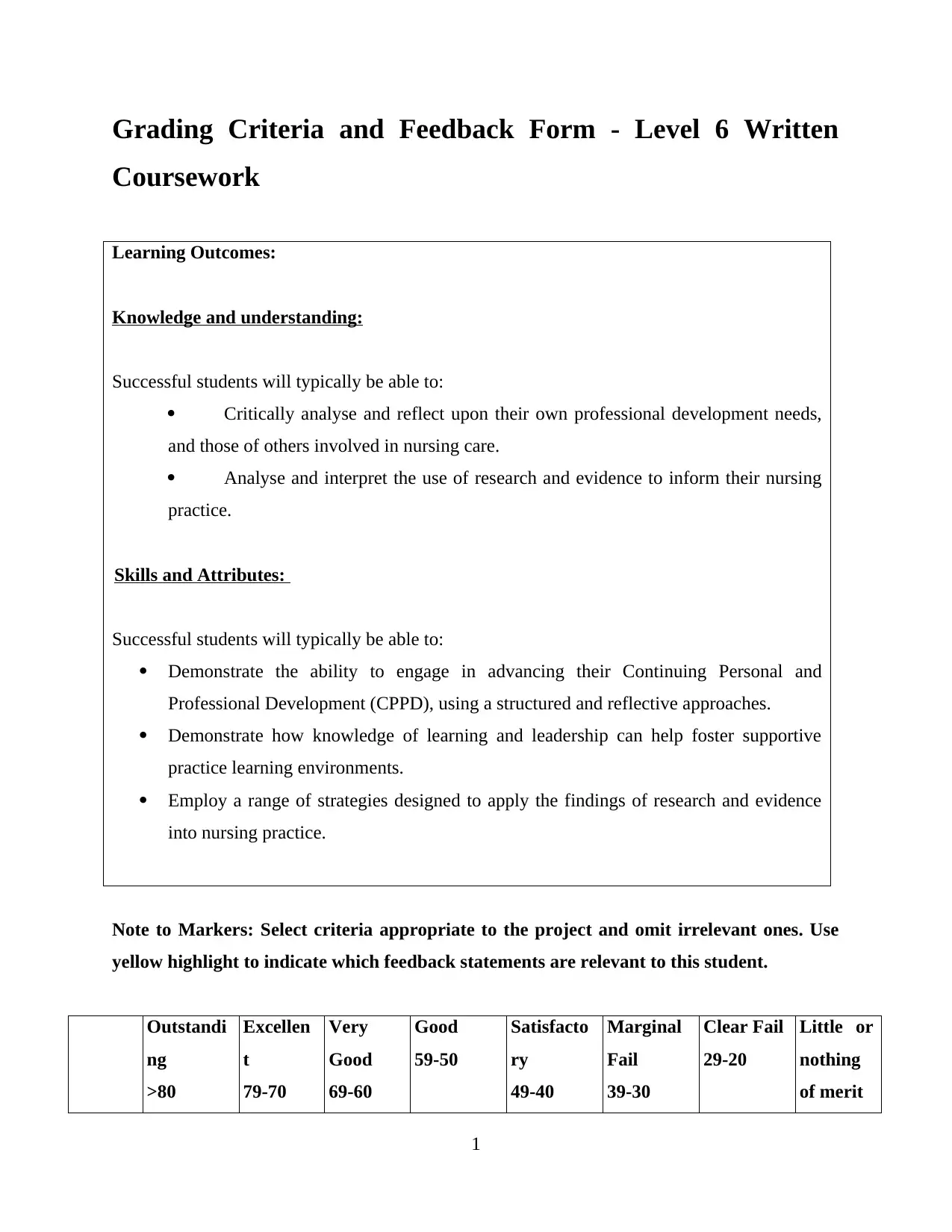
Grading Criteria and Feedback Form - Level 6 Written
Coursework
Learning Outcomes:
Knowledge and understanding:
Successful students will typically be able to:
Critically analyse and reflect upon their own professional development needs,
and those of others involved in nursing care.
Analyse and interpret the use of research and evidence to inform their nursing
practice.
Skills and Attributes:
Successful students will typically be able to:
Demonstrate the ability to engage in advancing their Continuing Personal and
Professional Development (CPPD), using a structured and reflective approaches.
Demonstrate how knowledge of learning and leadership can help foster supportive
practice learning environments.
Employ a range of strategies designed to apply the findings of research and evidence
into nursing practice.
Note to Markers: Select criteria appropriate to the project and omit irrelevant ones. Use
yellow highlight to indicate which feedback statements are relevant to this student.
Outstandi
ng
>80
Excellen
t
79-70
Very
Good
69-60
Good
59-50
Satisfacto
ry
49-40
Marginal
Fail
39-30
Clear Fail
29-20
Little or
nothing
of merit
1
Coursework
Learning Outcomes:
Knowledge and understanding:
Successful students will typically be able to:
Critically analyse and reflect upon their own professional development needs,
and those of others involved in nursing care.
Analyse and interpret the use of research and evidence to inform their nursing
practice.
Skills and Attributes:
Successful students will typically be able to:
Demonstrate the ability to engage in advancing their Continuing Personal and
Professional Development (CPPD), using a structured and reflective approaches.
Demonstrate how knowledge of learning and leadership can help foster supportive
practice learning environments.
Employ a range of strategies designed to apply the findings of research and evidence
into nursing practice.
Note to Markers: Select criteria appropriate to the project and omit irrelevant ones. Use
yellow highlight to indicate which feedback statements are relevant to this student.
Outstandi
ng
>80
Excellen
t
79-70
Very
Good
69-60
Good
59-50
Satisfacto
ry
49-40
Marginal
Fail
39-30
Clear Fail
29-20
Little or
nothing
of merit
1
Secure Best Marks with AI Grader
Need help grading? Try our AI Grader for instant feedback on your assignments.
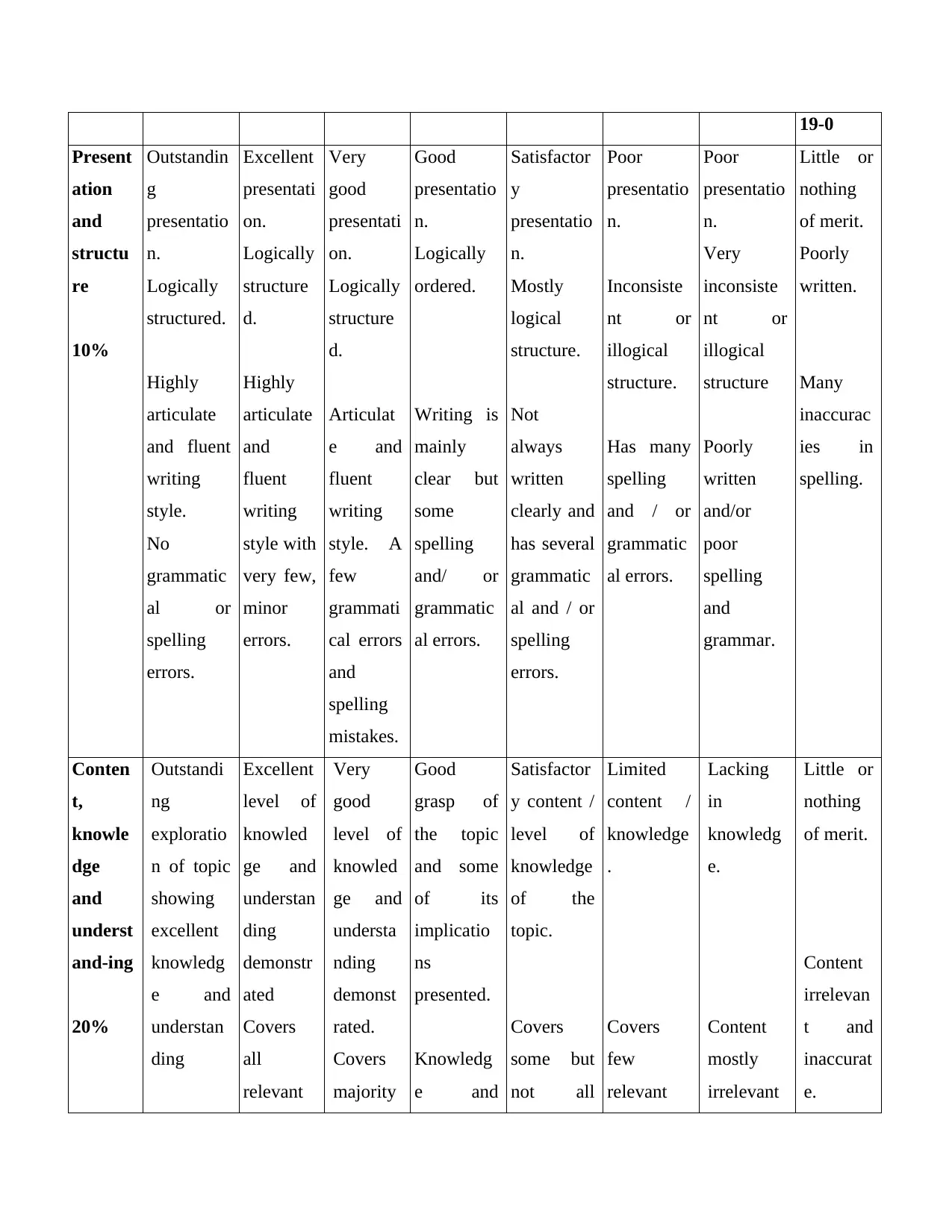
19-0
Present
ation
and
structu
re
10%
Outstandin
g
presentatio
n.
Logically
structured.
Highly
articulate
and fluent
writing
style.
No
grammatic
al or
spelling
errors.
Excellent
presentati
on.
Logically
structure
d.
Highly
articulate
and
fluent
writing
style with
very few,
minor
errors.
Very
good
presentati
on.
Logically
structure
d.
Articulat
e and
fluent
writing
style. A
few
grammati
cal errors
and
spelling
mistakes.
Good
presentatio
n.
Logically
ordered.
Writing is
mainly
clear but
some
spelling
and/ or
grammatic
al errors.
Satisfactor
y
presentatio
n.
Mostly
logical
structure.
Not
always
written
clearly and
has several
grammatic
al and / or
spelling
errors.
Poor
presentatio
n.
Inconsiste
nt or
illogical
structure.
Has many
spelling
and / or
grammatic
al errors.
Poor
presentatio
n.
Very
inconsiste
nt or
illogical
structure
Poorly
written
and/or
poor
spelling
and
grammar.
Little or
nothing
of merit.
Poorly
written.
Many
inaccurac
ies in
spelling.
Conten
t,
knowle
dge
and
underst
and-ing
20%
Outstandi
ng
exploratio
n of topic
showing
excellent
knowledg
e and
understan
ding
Excellent
level of
knowled
ge and
understan
ding
demonstr
ated
Covers
all
relevant
Very
good
level of
knowled
ge and
understa
nding
demonst
rated.
Covers
majority
Good
grasp of
the topic
and some
of its
implicatio
ns
presented.
Knowledg
e and
Satisfactor
y content /
level of
knowledge
of the
topic.
Covers
some but
not all
Limited
content /
knowledge
.
Covers
few
relevant
Lacking
in
knowledg
e.
Content
mostly
irrelevant
Little or
nothing
of merit.
Content
irrelevan
t and
inaccurat
e.
Present
ation
and
structu
re
10%
Outstandin
g
presentatio
n.
Logically
structured.
Highly
articulate
and fluent
writing
style.
No
grammatic
al or
spelling
errors.
Excellent
presentati
on.
Logically
structure
d.
Highly
articulate
and
fluent
writing
style with
very few,
minor
errors.
Very
good
presentati
on.
Logically
structure
d.
Articulat
e and
fluent
writing
style. A
few
grammati
cal errors
and
spelling
mistakes.
Good
presentatio
n.
Logically
ordered.
Writing is
mainly
clear but
some
spelling
and/ or
grammatic
al errors.
Satisfactor
y
presentatio
n.
Mostly
logical
structure.
Not
always
written
clearly and
has several
grammatic
al and / or
spelling
errors.
Poor
presentatio
n.
Inconsiste
nt or
illogical
structure.
Has many
spelling
and / or
grammatic
al errors.
Poor
presentatio
n.
Very
inconsiste
nt or
illogical
structure
Poorly
written
and/or
poor
spelling
and
grammar.
Little or
nothing
of merit.
Poorly
written.
Many
inaccurac
ies in
spelling.
Conten
t,
knowle
dge
and
underst
and-ing
20%
Outstandi
ng
exploratio
n of topic
showing
excellent
knowledg
e and
understan
ding
Excellent
level of
knowled
ge and
understan
ding
demonstr
ated
Covers
all
relevant
Very
good
level of
knowled
ge and
understa
nding
demonst
rated.
Covers
majority
Good
grasp of
the topic
and some
of its
implicatio
ns
presented.
Knowledg
e and
Satisfactor
y content /
level of
knowledge
of the
topic.
Covers
some but
not all
Limited
content /
knowledge
.
Covers
few
relevant
Lacking
in
knowledg
e.
Content
mostly
irrelevant
Little or
nothing
of merit.
Content
irrelevan
t and
inaccurat
e.
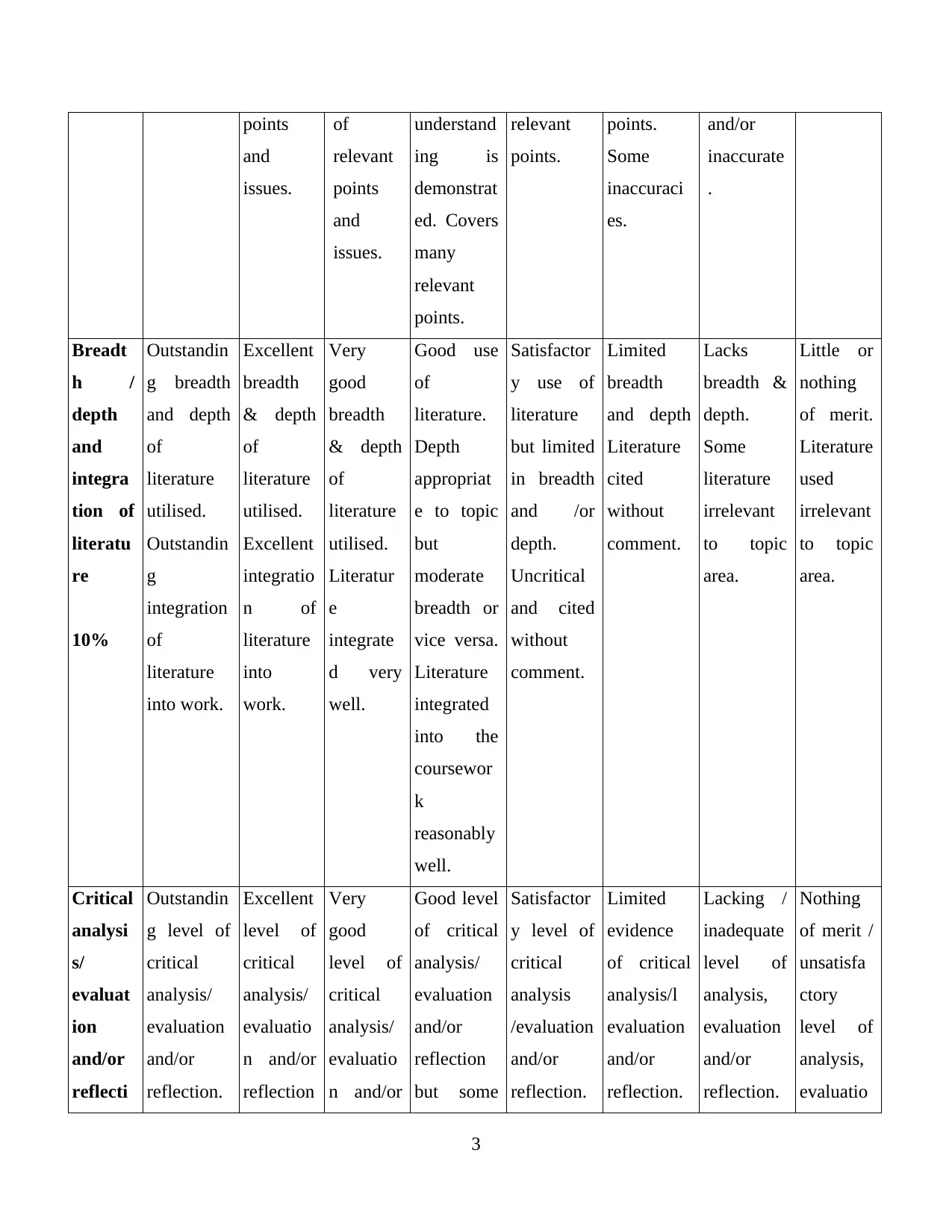
points
and
issues.
of
relevant
points
and
issues.
understand
ing is
demonstrat
ed. Covers
many
relevant
points.
relevant
points.
points.
Some
inaccuraci
es.
and/or
inaccurate
.
Breadt
h /
depth
and
integra
tion of
literatu
re
10%
Outstandin
g breadth
and depth
of
literature
utilised.
Outstandin
g
integration
of
literature
into work.
Excellent
breadth
& depth
of
literature
utilised.
Excellent
integratio
n of
literature
into
work.
Very
good
breadth
& depth
of
literature
utilised.
Literatur
e
integrate
d very
well.
Good use
of
literature.
Depth
appropriat
e to topic
but
moderate
breadth or
vice versa.
Literature
integrated
into the
coursewor
k
reasonably
well.
Satisfactor
y use of
literature
but limited
in breadth
and /or
depth.
Uncritical
and cited
without
comment.
Limited
breadth
and depth
Literature
cited
without
comment.
Lacks
breadth &
depth.
Some
literature
irrelevant
to topic
area.
Little or
nothing
of merit.
Literature
used
irrelevant
to topic
area.
Critical
analysi
s/
evaluat
ion
and/or
reflecti
Outstandin
g level of
critical
analysis/
evaluation
and/or
reflection.
Excellent
level of
critical
analysis/
evaluatio
n and/or
reflection
Very
good
level of
critical
analysis/
evaluatio
n and/or
Good level
of critical
analysis/
evaluation
and/or
reflection
but some
Satisfactor
y level of
critical
analysis
/evaluation
and/or
reflection.
Limited
evidence
of critical
analysis/l
evaluation
and/or
reflection.
Lacking /
inadequate
level of
analysis,
evaluation
and/or
reflection.
Nothing
of merit /
unsatisfa
ctory
level of
analysis,
evaluatio
3
and
issues.
of
relevant
points
and
issues.
understand
ing is
demonstrat
ed. Covers
many
relevant
points.
relevant
points.
points.
Some
inaccuraci
es.
and/or
inaccurate
.
Breadt
h /
depth
and
integra
tion of
literatu
re
10%
Outstandin
g breadth
and depth
of
literature
utilised.
Outstandin
g
integration
of
literature
into work.
Excellent
breadth
& depth
of
literature
utilised.
Excellent
integratio
n of
literature
into
work.
Very
good
breadth
& depth
of
literature
utilised.
Literatur
e
integrate
d very
well.
Good use
of
literature.
Depth
appropriat
e to topic
but
moderate
breadth or
vice versa.
Literature
integrated
into the
coursewor
k
reasonably
well.
Satisfactor
y use of
literature
but limited
in breadth
and /or
depth.
Uncritical
and cited
without
comment.
Limited
breadth
and depth
Literature
cited
without
comment.
Lacks
breadth &
depth.
Some
literature
irrelevant
to topic
area.
Little or
nothing
of merit.
Literature
used
irrelevant
to topic
area.
Critical
analysi
s/
evaluat
ion
and/or
reflecti
Outstandin
g level of
critical
analysis/
evaluation
and/or
reflection.
Excellent
level of
critical
analysis/
evaluatio
n and/or
reflection
Very
good
level of
critical
analysis/
evaluatio
n and/or
Good level
of critical
analysis/
evaluation
and/or
reflection
but some
Satisfactor
y level of
critical
analysis
/evaluation
and/or
reflection.
Limited
evidence
of critical
analysis/l
evaluation
and/or
reflection.
Lacking /
inadequate
level of
analysis,
evaluation
and/or
reflection.
Nothing
of merit /
unsatisfa
ctory
level of
analysis,
evaluatio
3
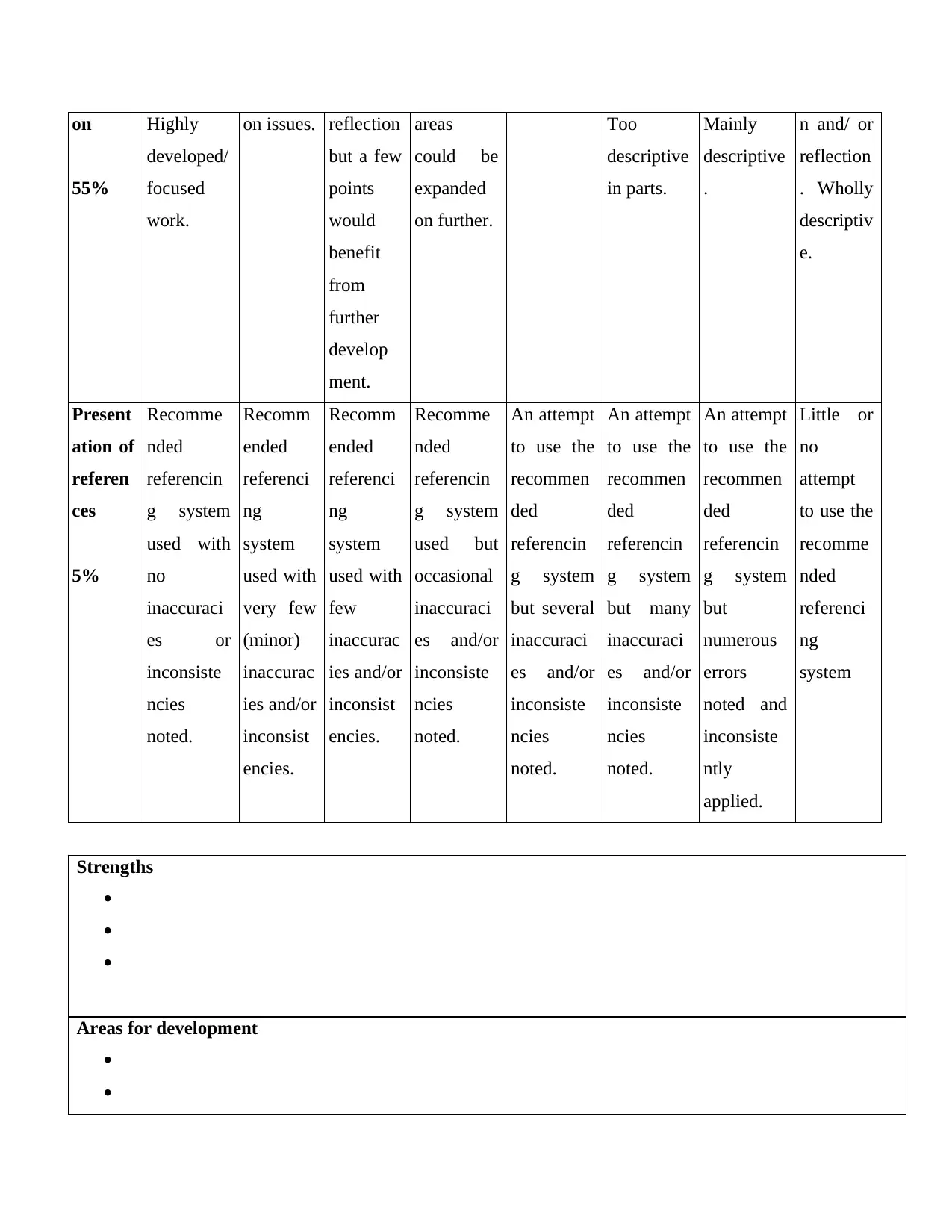
on
55%
Highly
developed/
focused
work.
on issues. reflection
but a few
points
would
benefit
from
further
develop
ment.
areas
could be
expanded
on further.
Too
descriptive
in parts.
Mainly
descriptive
.
n and/ or
reflection
. Wholly
descriptiv
e.
Present
ation of
referen
ces
5%
Recomme
nded
referencin
g system
used with
no
inaccuraci
es or
inconsiste
ncies
noted.
Recomm
ended
referenci
ng
system
used with
very few
(minor)
inaccurac
ies and/or
inconsist
encies.
Recomm
ended
referenci
ng
system
used with
few
inaccurac
ies and/or
inconsist
encies.
Recomme
nded
referencin
g system
used but
occasional
inaccuraci
es and/or
inconsiste
ncies
noted.
An attempt
to use the
recommen
ded
referencin
g system
but several
inaccuraci
es and/or
inconsiste
ncies
noted.
An attempt
to use the
recommen
ded
referencin
g system
but many
inaccuraci
es and/or
inconsiste
ncies
noted.
An attempt
to use the
recommen
ded
referencin
g system
but
numerous
errors
noted and
inconsiste
ntly
applied.
Little or
no
attempt
to use the
recomme
nded
referenci
ng
system
Strengths
Areas for development
55%
Highly
developed/
focused
work.
on issues. reflection
but a few
points
would
benefit
from
further
develop
ment.
areas
could be
expanded
on further.
Too
descriptive
in parts.
Mainly
descriptive
.
n and/ or
reflection
. Wholly
descriptiv
e.
Present
ation of
referen
ces
5%
Recomme
nded
referencin
g system
used with
no
inaccuraci
es or
inconsiste
ncies
noted.
Recomm
ended
referenci
ng
system
used with
very few
(minor)
inaccurac
ies and/or
inconsist
encies.
Recomm
ended
referenci
ng
system
used with
few
inaccurac
ies and/or
inconsist
encies.
Recomme
nded
referencin
g system
used but
occasional
inaccuraci
es and/or
inconsiste
ncies
noted.
An attempt
to use the
recommen
ded
referencin
g system
but several
inaccuraci
es and/or
inconsiste
ncies
noted.
An attempt
to use the
recommen
ded
referencin
g system
but many
inaccuraci
es and/or
inconsiste
ncies
noted.
An attempt
to use the
recommen
ded
referencin
g system
but
numerous
errors
noted and
inconsiste
ntly
applied.
Little or
no
attempt
to use the
recomme
nded
referenci
ng
system
Strengths
Areas for development
Secure Best Marks with AI Grader
Need help grading? Try our AI Grader for instant feedback on your assignments.
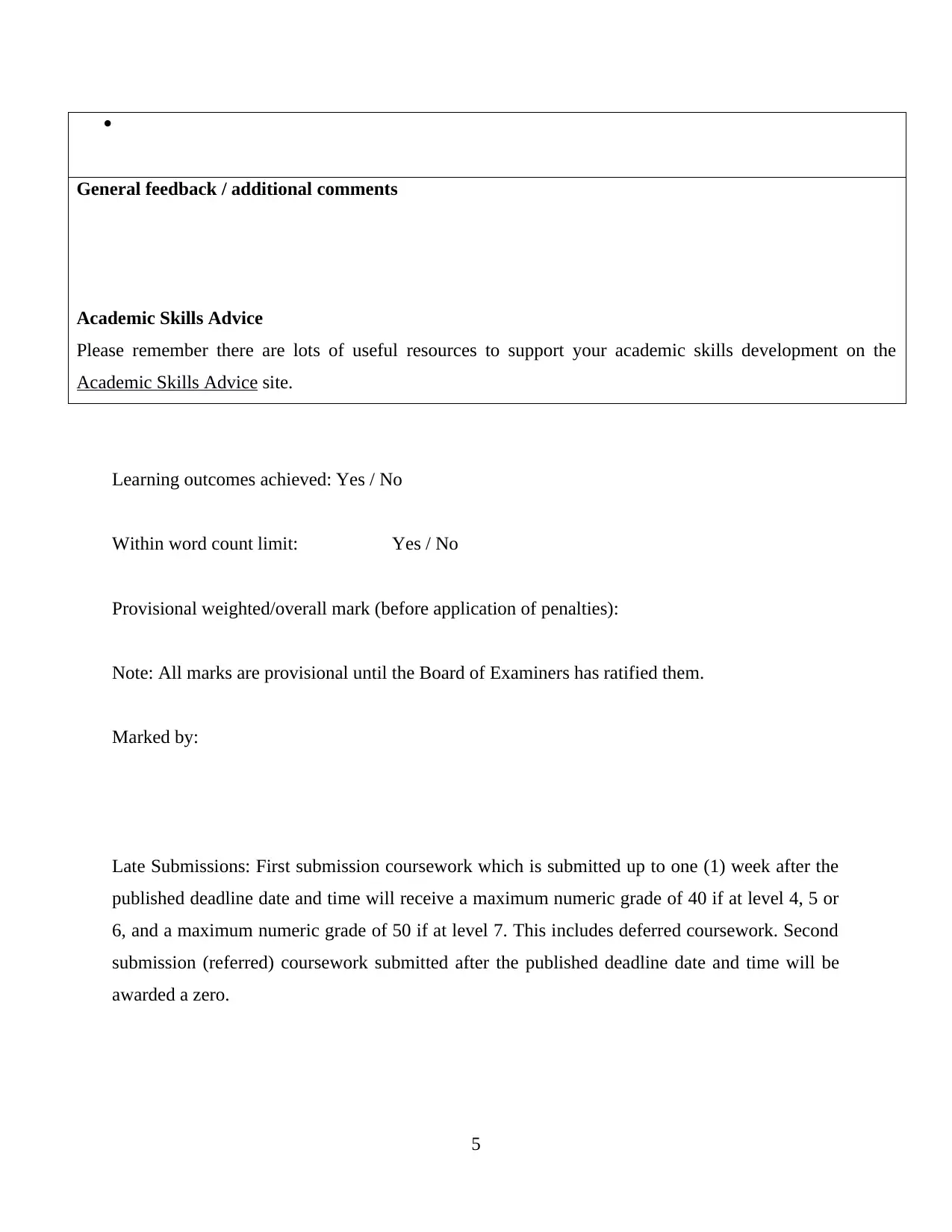
General feedback / additional comments
Academic Skills Advice
Please remember there are lots of useful resources to support your academic skills development on the
Academic Skills Advice site.
Learning outcomes achieved: Yes / No
Within word count limit: Yes / No
Provisional weighted/overall mark (before application of penalties):
Note: All marks are provisional until the Board of Examiners has ratified them.
Marked by:
Late Submissions: First submission coursework which is submitted up to one (1) week after the
published deadline date and time will receive a maximum numeric grade of 40 if at level 4, 5 or
6, and a maximum numeric grade of 50 if at level 7. This includes deferred coursework. Second
submission (referred) coursework submitted after the published deadline date and time will be
awarded a zero.
5
General feedback / additional comments
Academic Skills Advice
Please remember there are lots of useful resources to support your academic skills development on the
Academic Skills Advice site.
Learning outcomes achieved: Yes / No
Within word count limit: Yes / No
Provisional weighted/overall mark (before application of penalties):
Note: All marks are provisional until the Board of Examiners has ratified them.
Marked by:
Late Submissions: First submission coursework which is submitted up to one (1) week after the
published deadline date and time will receive a maximum numeric grade of 40 if at level 4, 5 or
6, and a maximum numeric grade of 50 if at level 7. This includes deferred coursework. Second
submission (referred) coursework submitted after the published deadline date and time will be
awarded a zero.
5
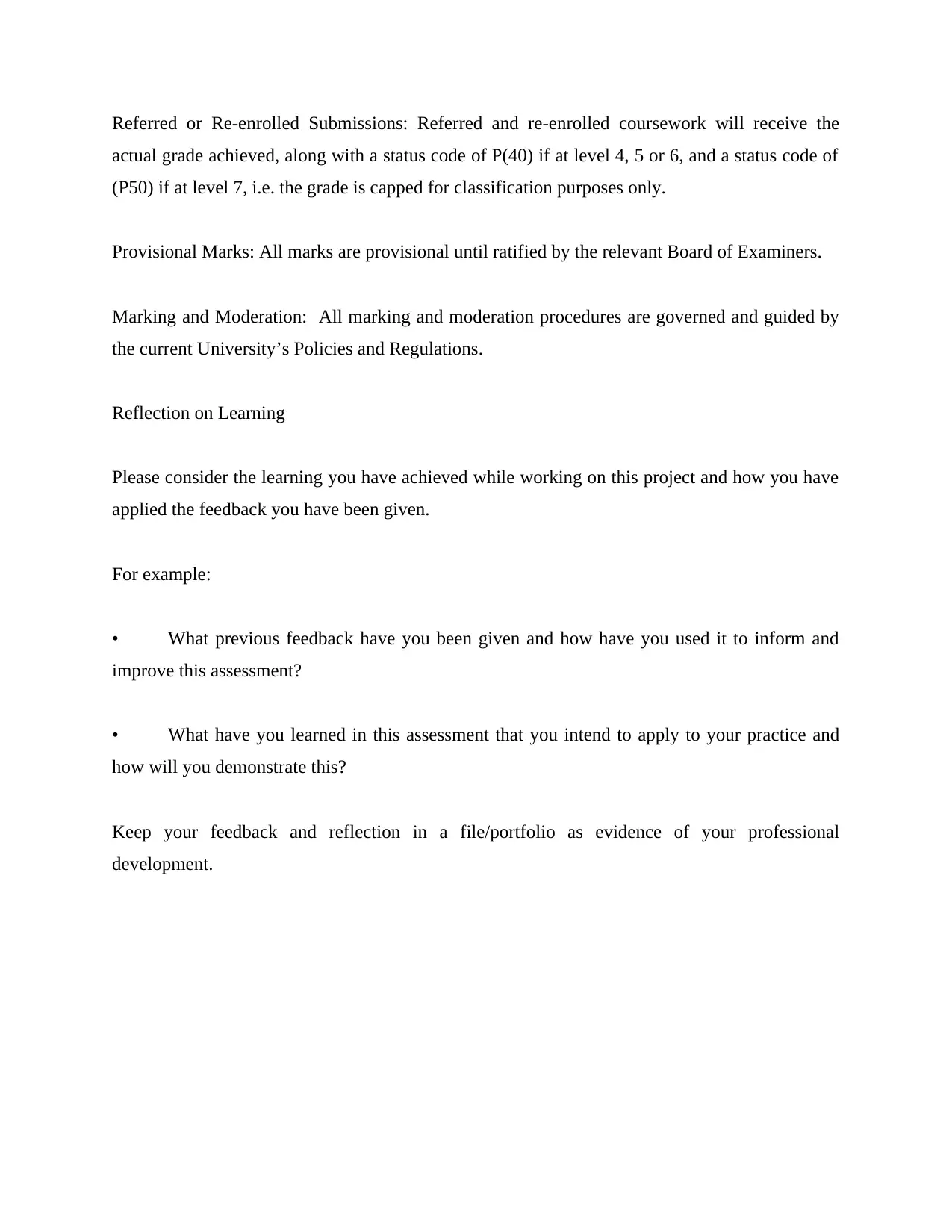
Referred or Re-enrolled Submissions: Referred and re-enrolled coursework will receive the
actual grade achieved, along with a status code of P(40) if at level 4, 5 or 6, and a status code of
(P50) if at level 7, i.e. the grade is capped for classification purposes only.
Provisional Marks: All marks are provisional until ratified by the relevant Board of Examiners.
Marking and Moderation: All marking and moderation procedures are governed and guided by
the current University’s Policies and Regulations.
Reflection on Learning
Please consider the learning you have achieved while working on this project and how you have
applied the feedback you have been given.
For example:
• What previous feedback have you been given and how have you used it to inform and
improve this assessment?
• What have you learned in this assessment that you intend to apply to your practice and
how will you demonstrate this?
Keep your feedback and reflection in a file/portfolio as evidence of your professional
development.
actual grade achieved, along with a status code of P(40) if at level 4, 5 or 6, and a status code of
(P50) if at level 7, i.e. the grade is capped for classification purposes only.
Provisional Marks: All marks are provisional until ratified by the relevant Board of Examiners.
Marking and Moderation: All marking and moderation procedures are governed and guided by
the current University’s Policies and Regulations.
Reflection on Learning
Please consider the learning you have achieved while working on this project and how you have
applied the feedback you have been given.
For example:
• What previous feedback have you been given and how have you used it to inform and
improve this assessment?
• What have you learned in this assessment that you intend to apply to your practice and
how will you demonstrate this?
Keep your feedback and reflection in a file/portfolio as evidence of your professional
development.
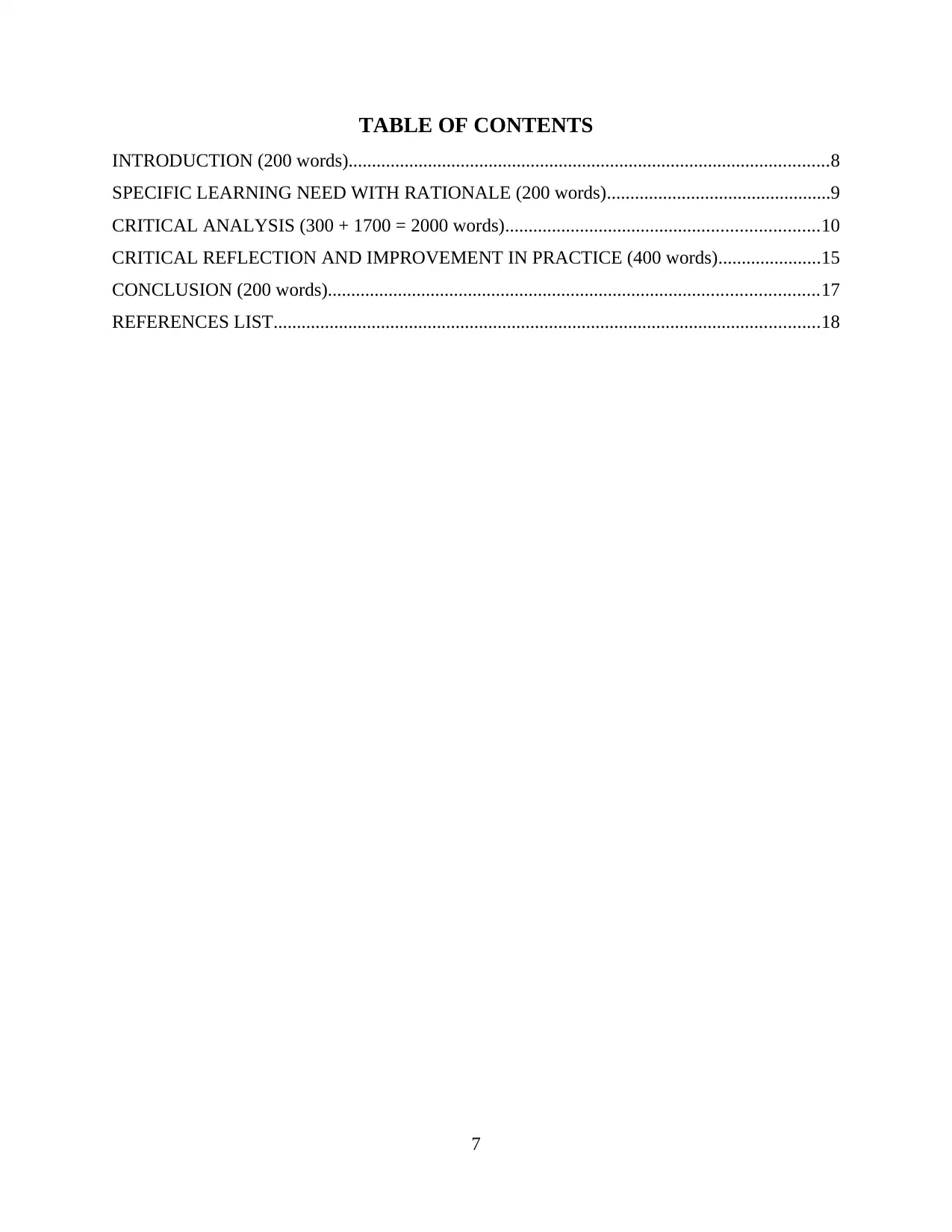
TABLE OF CONTENTS
INTRODUCTION (200 words).......................................................................................................8
SPECIFIC LEARNING NEED WITH RATIONALE (200 words)................................................9
CRITICAL ANALYSIS (300 + 1700 = 2000 words)...................................................................10
CRITICAL REFLECTION AND IMPROVEMENT IN PRACTICE (400 words)......................15
CONCLUSION (200 words).........................................................................................................17
REFERENCES LIST.....................................................................................................................18
7
INTRODUCTION (200 words).......................................................................................................8
SPECIFIC LEARNING NEED WITH RATIONALE (200 words)................................................9
CRITICAL ANALYSIS (300 + 1700 = 2000 words)...................................................................10
CRITICAL REFLECTION AND IMPROVEMENT IN PRACTICE (400 words)......................15
CONCLUSION (200 words).........................................................................................................17
REFERENCES LIST.....................................................................................................................18
7
Paraphrase This Document
Need a fresh take? Get an instant paraphrase of this document with our AI Paraphraser
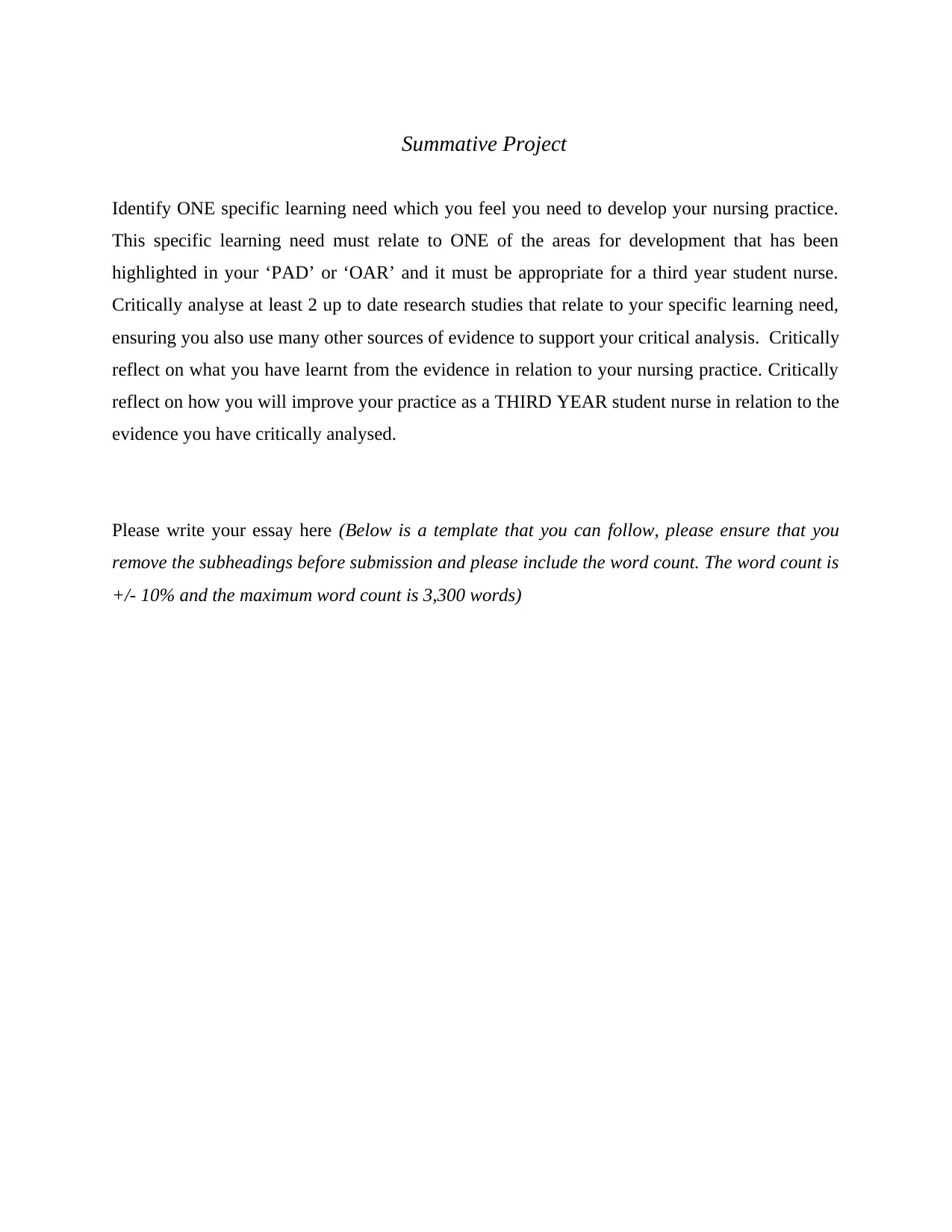
Summative Project
Identify ONE specific learning need which you feel you need to develop your nursing practice.
This specific learning need must relate to ONE of the areas for development that has been
highlighted in your ‘PAD’ or ‘OAR’ and it must be appropriate for a third year student nurse.
Critically analyse at least 2 up to date research studies that relate to your specific learning need,
ensuring you also use many other sources of evidence to support your critical analysis. Critically
reflect on what you have learnt from the evidence in relation to your nursing practice. Critically
reflect on how you will improve your practice as a THIRD YEAR student nurse in relation to the
evidence you have critically analysed.
Please write your essay here (Below is a template that you can follow, please ensure that you
remove the subheadings before submission and please include the word count. The word count is
+/- 10% and the maximum word count is 3,300 words)
Identify ONE specific learning need which you feel you need to develop your nursing practice.
This specific learning need must relate to ONE of the areas for development that has been
highlighted in your ‘PAD’ or ‘OAR’ and it must be appropriate for a third year student nurse.
Critically analyse at least 2 up to date research studies that relate to your specific learning need,
ensuring you also use many other sources of evidence to support your critical analysis. Critically
reflect on what you have learnt from the evidence in relation to your nursing practice. Critically
reflect on how you will improve your practice as a THIRD YEAR student nurse in relation to the
evidence you have critically analysed.
Please write your essay here (Below is a template that you can follow, please ensure that you
remove the subheadings before submission and please include the word count. The word count is
+/- 10% and the maximum word count is 3,300 words)

INTRODUCTION (200 words)
The fundamental aim of any handover is to accomplish efficient transfer of high quality
clinical information at the time of transition of responsibility for patient. Shift work also relies on
effective information that transfers to protect the patient’s safety (De Brún, Heavey and Scott,
2017). Present report provides critical discussion to maintain ongoing confidentiality regarding
patient’s records. Nursing changes in shift with communication can be occur between different
aspects of nurses for accomplish specific purpose. To communicate information regarding
patient’s care has been taken for nurses effectively. There are two articles taken in which
importance of SBAR tool is considered as an evidence into nursing practices.
In one article, SBAR tool explained for communication and patient’s safety which is
considered to be an integrated literature review. For this purpose in this report Continuing
Personal and Professional Development (CPPD) will be used so that learner could be able to
reflect upon what is learned and what development needs to be done. Within the particular error
of communication, there are prevalent sources of miscalculation and misdirection in healthcare
field. On the other hand, another article shows that without standardisation and communication
in between healthcare providers, patient’s safety may be in jeopardy. Therefore, it is the key
component to provide proper care and meet with improvement with high quality of care.
SPECIFIC LEARNING NEED WITH RATIONALE (200 words)
Communication is an essential part of healthcare which means transfer of information
related to patients which will be done in between 2 or more people. However, there could also be
many chances where poor or lack of communication has been found that would be leading to
sentinel events. The present study is based on methods of improving communication process
among bedside nursing staff and skilled nursing rehabilitation unit (Acharya, Thomas and
Hellaby, 2017). So under this evidence based communication through use of SBAR tool at time
of bed handoff which is having positive impact on reducing falling rates. For this random
controlled trails (RCT) that evaluated the handover style between the nurses within hospital
setting is used. According to this consideration, it can be stated that healthcare system is more
often with root cause of errors that traced to faulty systematic processes.
9
The fundamental aim of any handover is to accomplish efficient transfer of high quality
clinical information at the time of transition of responsibility for patient. Shift work also relies on
effective information that transfers to protect the patient’s safety (De Brún, Heavey and Scott,
2017). Present report provides critical discussion to maintain ongoing confidentiality regarding
patient’s records. Nursing changes in shift with communication can be occur between different
aspects of nurses for accomplish specific purpose. To communicate information regarding
patient’s care has been taken for nurses effectively. There are two articles taken in which
importance of SBAR tool is considered as an evidence into nursing practices.
In one article, SBAR tool explained for communication and patient’s safety which is
considered to be an integrated literature review. For this purpose in this report Continuing
Personal and Professional Development (CPPD) will be used so that learner could be able to
reflect upon what is learned and what development needs to be done. Within the particular error
of communication, there are prevalent sources of miscalculation and misdirection in healthcare
field. On the other hand, another article shows that without standardisation and communication
in between healthcare providers, patient’s safety may be in jeopardy. Therefore, it is the key
component to provide proper care and meet with improvement with high quality of care.
SPECIFIC LEARNING NEED WITH RATIONALE (200 words)
Communication is an essential part of healthcare which means transfer of information
related to patients which will be done in between 2 or more people. However, there could also be
many chances where poor or lack of communication has been found that would be leading to
sentinel events. The present study is based on methods of improving communication process
among bedside nursing staff and skilled nursing rehabilitation unit (Acharya, Thomas and
Hellaby, 2017). So under this evidence based communication through use of SBAR tool at time
of bed handoff which is having positive impact on reducing falling rates. For this random
controlled trails (RCT) that evaluated the handover style between the nurses within hospital
setting is used. According to this consideration, it can be stated that healthcare system is more
often with root cause of errors that traced to faulty systematic processes.
9
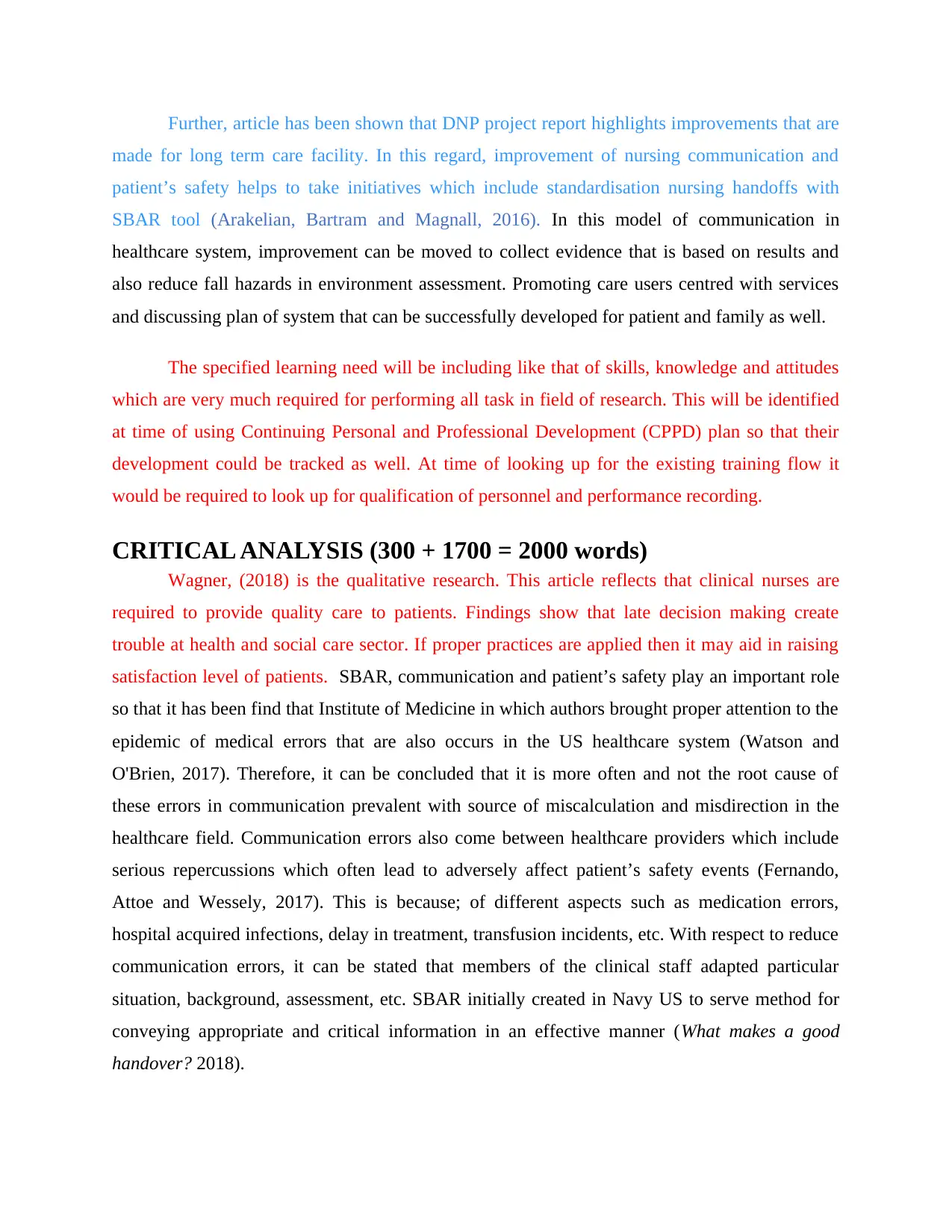
Further, article has been shown that DNP project report highlights improvements that are
made for long term care facility. In this regard, improvement of nursing communication and
patient’s safety helps to take initiatives which include standardisation nursing handoffs with
SBAR tool (Arakelian, Bartram and Magnall, 2016). In this model of communication in
healthcare system, improvement can be moved to collect evidence that is based on results and
also reduce fall hazards in environment assessment. Promoting care users centred with services
and discussing plan of system that can be successfully developed for patient and family as well.
The specified learning need will be including like that of skills, knowledge and attitudes
which are very much required for performing all task in field of research. This will be identified
at time of using Continuing Personal and Professional Development (CPPD) plan so that their
development could be tracked as well. At time of looking up for the existing training flow it
would be required to look up for qualification of personnel and performance recording.
CRITICAL ANALYSIS (300 + 1700 = 2000 words)
Wagner, (2018) is the qualitative research. This article reflects that clinical nurses are
required to provide quality care to patients. Findings show that late decision making create
trouble at health and social care sector. If proper practices are applied then it may aid in raising
satisfaction level of patients. SBAR, communication and patient’s safety play an important role
so that it has been find that Institute of Medicine in which authors brought proper attention to the
epidemic of medical errors that are also occurs in the US healthcare system (Watson and
O'Brien, 2017). Therefore, it can be concluded that it is more often and not the root cause of
these errors in communication prevalent with source of miscalculation and misdirection in the
healthcare field. Communication errors also come between healthcare providers which include
serious repercussions which often lead to adversely affect patient’s safety events (Fernando,
Attoe and Wessely, 2017). This is because; of different aspects such as medication errors,
hospital acquired infections, delay in treatment, transfusion incidents, etc. With respect to reduce
communication errors, it can be stated that members of the clinical staff adapted particular
situation, background, assessment, etc. SBAR initially created in Navy US to serve method for
conveying appropriate and critical information in an effective manner (What makes a good
handover? 2018).
made for long term care facility. In this regard, improvement of nursing communication and
patient’s safety helps to take initiatives which include standardisation nursing handoffs with
SBAR tool (Arakelian, Bartram and Magnall, 2016). In this model of communication in
healthcare system, improvement can be moved to collect evidence that is based on results and
also reduce fall hazards in environment assessment. Promoting care users centred with services
and discussing plan of system that can be successfully developed for patient and family as well.
The specified learning need will be including like that of skills, knowledge and attitudes
which are very much required for performing all task in field of research. This will be identified
at time of using Continuing Personal and Professional Development (CPPD) plan so that their
development could be tracked as well. At time of looking up for the existing training flow it
would be required to look up for qualification of personnel and performance recording.
CRITICAL ANALYSIS (300 + 1700 = 2000 words)
Wagner, (2018) is the qualitative research. This article reflects that clinical nurses are
required to provide quality care to patients. Findings show that late decision making create
trouble at health and social care sector. If proper practices are applied then it may aid in raising
satisfaction level of patients. SBAR, communication and patient’s safety play an important role
so that it has been find that Institute of Medicine in which authors brought proper attention to the
epidemic of medical errors that are also occurs in the US healthcare system (Watson and
O'Brien, 2017). Therefore, it can be concluded that it is more often and not the root cause of
these errors in communication prevalent with source of miscalculation and misdirection in the
healthcare field. Communication errors also come between healthcare providers which include
serious repercussions which often lead to adversely affect patient’s safety events (Fernando,
Attoe and Wessely, 2017). This is because; of different aspects such as medication errors,
hospital acquired infections, delay in treatment, transfusion incidents, etc. With respect to reduce
communication errors, it can be stated that members of the clinical staff adapted particular
situation, background, assessment, etc. SBAR initially created in Navy US to serve method for
conveying appropriate and critical information in an effective manner (What makes a good
handover? 2018).
Secure Best Marks with AI Grader
Need help grading? Try our AI Grader for instant feedback on your assignments.
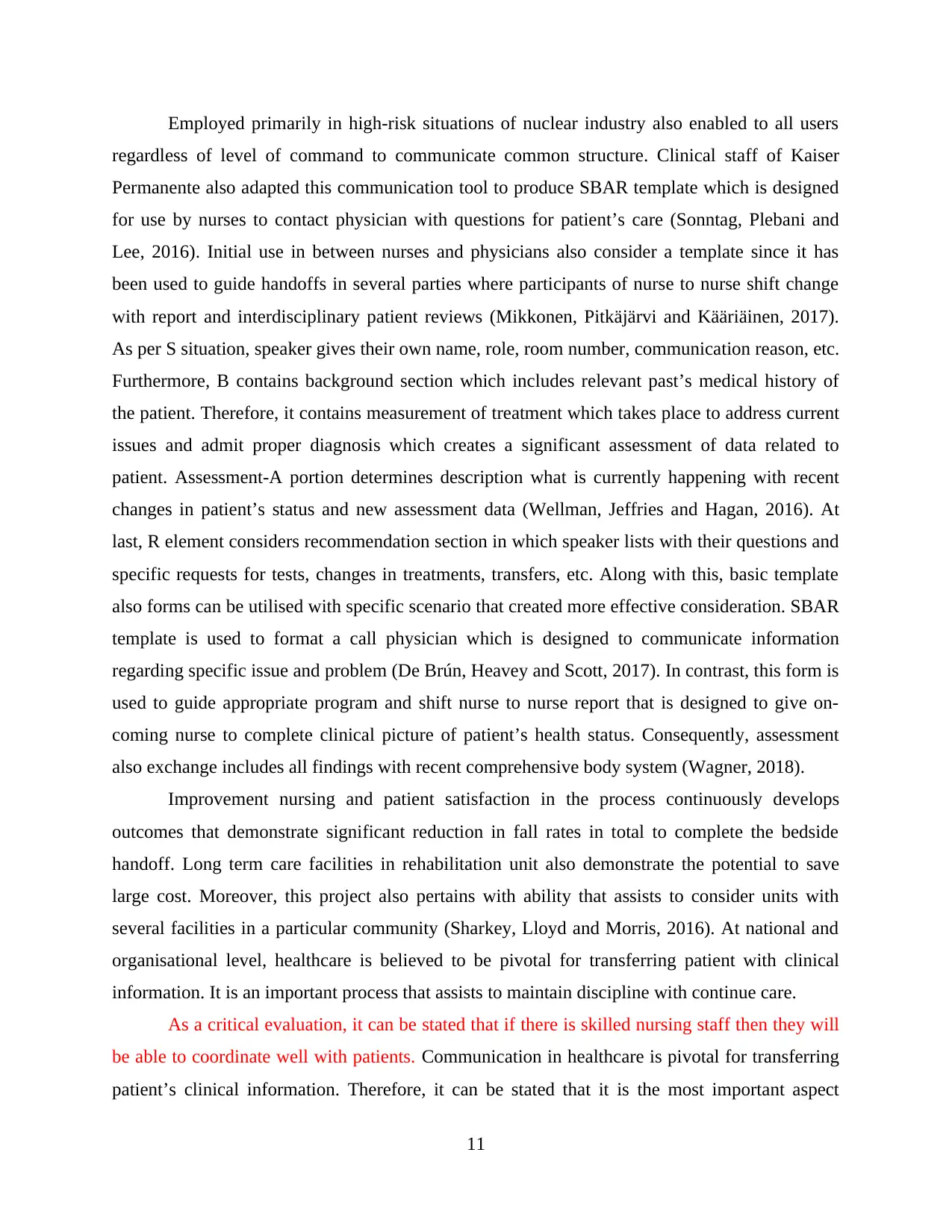
Employed primarily in high-risk situations of nuclear industry also enabled to all users
regardless of level of command to communicate common structure. Clinical staff of Kaiser
Permanente also adapted this communication tool to produce SBAR template which is designed
for use by nurses to contact physician with questions for patient’s care (Sonntag, Plebani and
Lee, 2016). Initial use in between nurses and physicians also consider a template since it has
been used to guide handoffs in several parties where participants of nurse to nurse shift change
with report and interdisciplinary patient reviews (Mikkonen, Pitkäjärvi and Kääriäinen, 2017).
As per S situation, speaker gives their own name, role, room number, communication reason, etc.
Furthermore, B contains background section which includes relevant past’s medical history of
the patient. Therefore, it contains measurement of treatment which takes place to address current
issues and admit proper diagnosis which creates a significant assessment of data related to
patient. Assessment-A portion determines description what is currently happening with recent
changes in patient’s status and new assessment data (Wellman, Jeffries and Hagan, 2016). At
last, R element considers recommendation section in which speaker lists with their questions and
specific requests for tests, changes in treatments, transfers, etc. Along with this, basic template
also forms can be utilised with specific scenario that created more effective consideration. SBAR
template is used to format a call physician which is designed to communicate information
regarding specific issue and problem (De Brún, Heavey and Scott, 2017). In contrast, this form is
used to guide appropriate program and shift nurse to nurse report that is designed to give on-
coming nurse to complete clinical picture of patient’s health status. Consequently, assessment
also exchange includes all findings with recent comprehensive body system (Wagner, 2018).
Improvement nursing and patient satisfaction in the process continuously develops
outcomes that demonstrate significant reduction in fall rates in total to complete the bedside
handoff. Long term care facilities in rehabilitation unit also demonstrate the potential to save
large cost. Moreover, this project also pertains with ability that assists to consider units with
several facilities in a particular community (Sharkey, Lloyd and Morris, 2016). At national and
organisational level, healthcare is believed to be pivotal for transferring patient with clinical
information. It is an important process that assists to maintain discipline with continue care.
As a critical evaluation, it can be stated that if there is skilled nursing staff then they will
be able to coordinate well with patients. Communication in healthcare is pivotal for transferring
patient’s clinical information. Therefore, it can be stated that it is the most important aspect
11
regardless of level of command to communicate common structure. Clinical staff of Kaiser
Permanente also adapted this communication tool to produce SBAR template which is designed
for use by nurses to contact physician with questions for patient’s care (Sonntag, Plebani and
Lee, 2016). Initial use in between nurses and physicians also consider a template since it has
been used to guide handoffs in several parties where participants of nurse to nurse shift change
with report and interdisciplinary patient reviews (Mikkonen, Pitkäjärvi and Kääriäinen, 2017).
As per S situation, speaker gives their own name, role, room number, communication reason, etc.
Furthermore, B contains background section which includes relevant past’s medical history of
the patient. Therefore, it contains measurement of treatment which takes place to address current
issues and admit proper diagnosis which creates a significant assessment of data related to
patient. Assessment-A portion determines description what is currently happening with recent
changes in patient’s status and new assessment data (Wellman, Jeffries and Hagan, 2016). At
last, R element considers recommendation section in which speaker lists with their questions and
specific requests for tests, changes in treatments, transfers, etc. Along with this, basic template
also forms can be utilised with specific scenario that created more effective consideration. SBAR
template is used to format a call physician which is designed to communicate information
regarding specific issue and problem (De Brún, Heavey and Scott, 2017). In contrast, this form is
used to guide appropriate program and shift nurse to nurse report that is designed to give on-
coming nurse to complete clinical picture of patient’s health status. Consequently, assessment
also exchange includes all findings with recent comprehensive body system (Wagner, 2018).
Improvement nursing and patient satisfaction in the process continuously develops
outcomes that demonstrate significant reduction in fall rates in total to complete the bedside
handoff. Long term care facilities in rehabilitation unit also demonstrate the potential to save
large cost. Moreover, this project also pertains with ability that assists to consider units with
several facilities in a particular community (Sharkey, Lloyd and Morris, 2016). At national and
organisational level, healthcare is believed to be pivotal for transferring patient with clinical
information. It is an important process that assists to maintain discipline with continue care.
As a critical evaluation, it can be stated that if there is skilled nursing staff then they will
be able to coordinate well with patients. Communication in healthcare is pivotal for transferring
patient’s clinical information. Therefore, it can be stated that it is the most important aspect
11
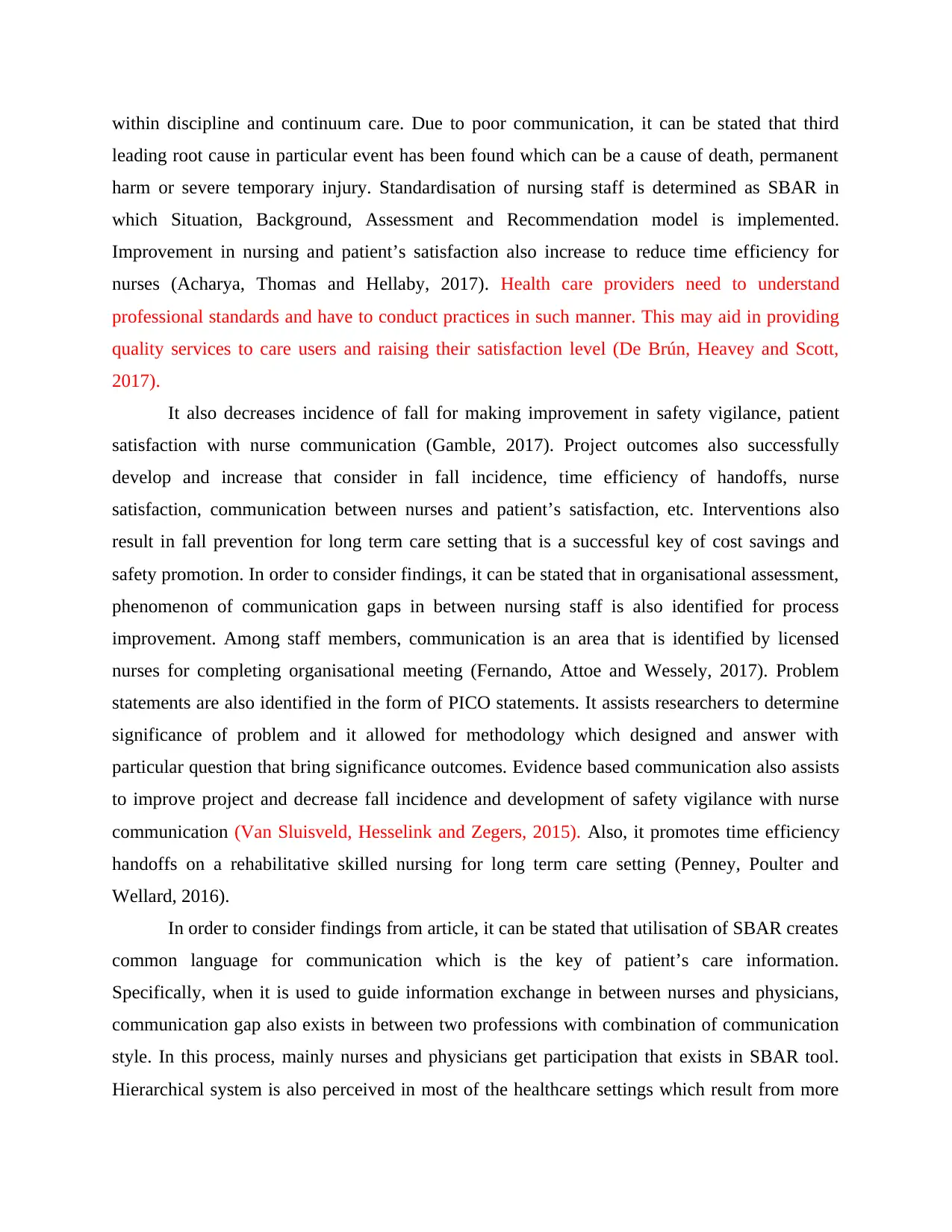
within discipline and continuum care. Due to poor communication, it can be stated that third
leading root cause in particular event has been found which can be a cause of death, permanent
harm or severe temporary injury. Standardisation of nursing staff is determined as SBAR in
which Situation, Background, Assessment and Recommendation model is implemented.
Improvement in nursing and patient’s satisfaction also increase to reduce time efficiency for
nurses (Acharya, Thomas and Hellaby, 2017). Health care providers need to understand
professional standards and have to conduct practices in such manner. This may aid in providing
quality services to care users and raising their satisfaction level (De Brún, Heavey and Scott,
2017).
It also decreases incidence of fall for making improvement in safety vigilance, patient
satisfaction with nurse communication (Gamble, 2017). Project outcomes also successfully
develop and increase that consider in fall incidence, time efficiency of handoffs, nurse
satisfaction, communication between nurses and patient’s satisfaction, etc. Interventions also
result in fall prevention for long term care setting that is a successful key of cost savings and
safety promotion. In order to consider findings, it can be stated that in organisational assessment,
phenomenon of communication gaps in between nursing staff is also identified for process
improvement. Among staff members, communication is an area that is identified by licensed
nurses for completing organisational meeting (Fernando, Attoe and Wessely, 2017). Problem
statements are also identified in the form of PICO statements. It assists researchers to determine
significance of problem and it allowed for methodology which designed and answer with
particular question that bring significance outcomes. Evidence based communication also assists
to improve project and decrease fall incidence and development of safety vigilance with nurse
communication (Van Sluisveld, Hesselink and Zegers, 2015). Also, it promotes time efficiency
handoffs on a rehabilitative skilled nursing for long term care setting (Penney, Poulter and
Wellard, 2016).
In order to consider findings from article, it can be stated that utilisation of SBAR creates
common language for communication which is the key of patient’s care information.
Specifically, when it is used to guide information exchange in between nurses and physicians,
communication gap also exists in between two professions with combination of communication
style. In this process, mainly nurses and physicians get participation that exists in SBAR tool.
Hierarchical system is also perceived in most of the healthcare settings which result from more
leading root cause in particular event has been found which can be a cause of death, permanent
harm or severe temporary injury. Standardisation of nursing staff is determined as SBAR in
which Situation, Background, Assessment and Recommendation model is implemented.
Improvement in nursing and patient’s satisfaction also increase to reduce time efficiency for
nurses (Acharya, Thomas and Hellaby, 2017). Health care providers need to understand
professional standards and have to conduct practices in such manner. This may aid in providing
quality services to care users and raising their satisfaction level (De Brún, Heavey and Scott,
2017).
It also decreases incidence of fall for making improvement in safety vigilance, patient
satisfaction with nurse communication (Gamble, 2017). Project outcomes also successfully
develop and increase that consider in fall incidence, time efficiency of handoffs, nurse
satisfaction, communication between nurses and patient’s satisfaction, etc. Interventions also
result in fall prevention for long term care setting that is a successful key of cost savings and
safety promotion. In order to consider findings, it can be stated that in organisational assessment,
phenomenon of communication gaps in between nursing staff is also identified for process
improvement. Among staff members, communication is an area that is identified by licensed
nurses for completing organisational meeting (Fernando, Attoe and Wessely, 2017). Problem
statements are also identified in the form of PICO statements. It assists researchers to determine
significance of problem and it allowed for methodology which designed and answer with
particular question that bring significance outcomes. Evidence based communication also assists
to improve project and decrease fall incidence and development of safety vigilance with nurse
communication (Van Sluisveld, Hesselink and Zegers, 2015). Also, it promotes time efficiency
handoffs on a rehabilitative skilled nursing for long term care setting (Penney, Poulter and
Wellard, 2016).
In order to consider findings from article, it can be stated that utilisation of SBAR creates
common language for communication which is the key of patient’s care information.
Specifically, when it is used to guide information exchange in between nurses and physicians,
communication gap also exists in between two professions with combination of communication
style. In this process, mainly nurses and physicians get participation that exists in SBAR tool.
Hierarchical system is also perceived in most of the healthcare settings which result from more
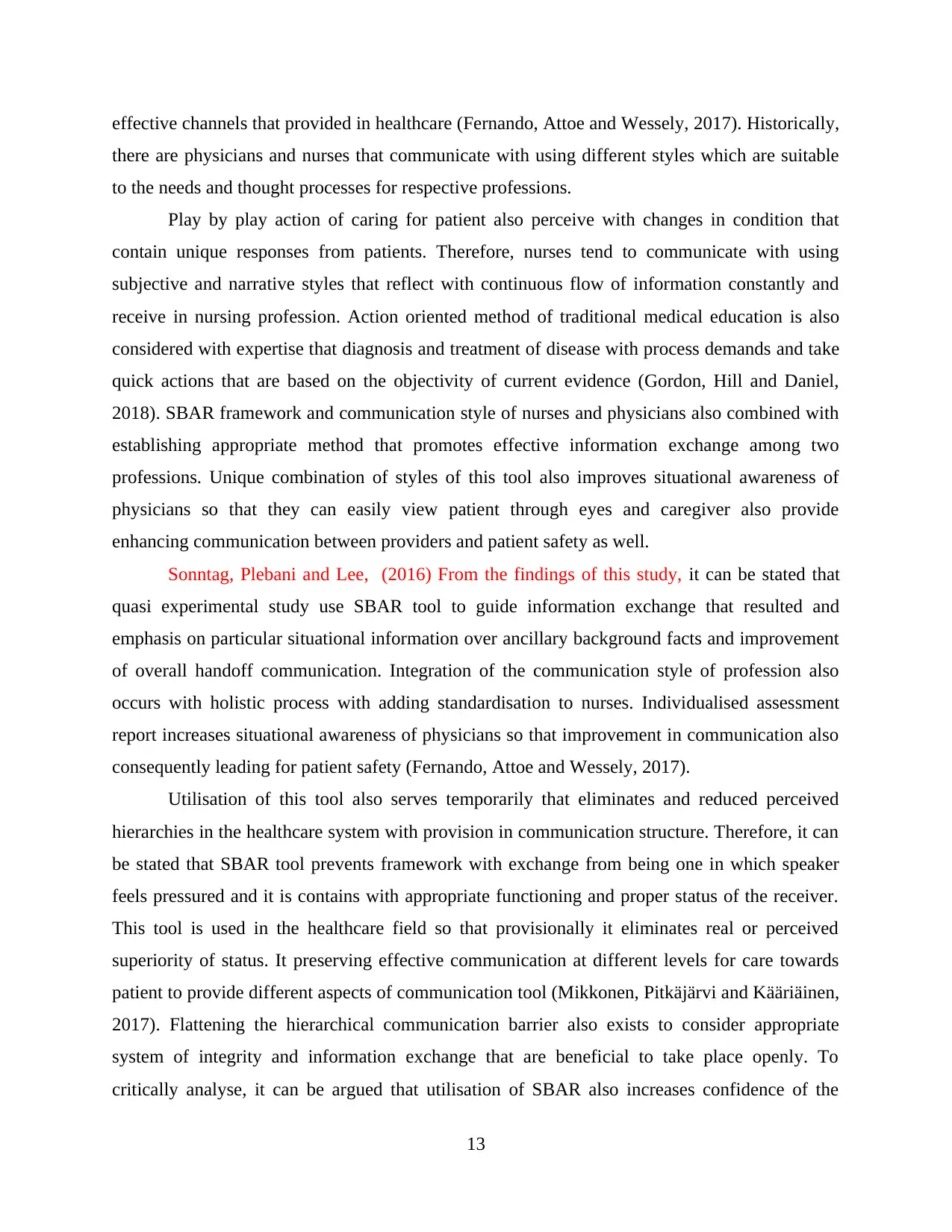
effective channels that provided in healthcare (Fernando, Attoe and Wessely, 2017). Historically,
there are physicians and nurses that communicate with using different styles which are suitable
to the needs and thought processes for respective professions.
Play by play action of caring for patient also perceive with changes in condition that
contain unique responses from patients. Therefore, nurses tend to communicate with using
subjective and narrative styles that reflect with continuous flow of information constantly and
receive in nursing profession. Action oriented method of traditional medical education is also
considered with expertise that diagnosis and treatment of disease with process demands and take
quick actions that are based on the objectivity of current evidence (Gordon, Hill and Daniel,
2018). SBAR framework and communication style of nurses and physicians also combined with
establishing appropriate method that promotes effective information exchange among two
professions. Unique combination of styles of this tool also improves situational awareness of
physicians so that they can easily view patient through eyes and caregiver also provide
enhancing communication between providers and patient safety as well.
Sonntag, Plebani and Lee, (2016) From the findings of this study, it can be stated that
quasi experimental study use SBAR tool to guide information exchange that resulted and
emphasis on particular situational information over ancillary background facts and improvement
of overall handoff communication. Integration of the communication style of profession also
occurs with holistic process with adding standardisation to nurses. Individualised assessment
report increases situational awareness of physicians so that improvement in communication also
consequently leading for patient safety (Fernando, Attoe and Wessely, 2017).
Utilisation of this tool also serves temporarily that eliminates and reduced perceived
hierarchies in the healthcare system with provision in communication structure. Therefore, it can
be stated that SBAR tool prevents framework with exchange from being one in which speaker
feels pressured and it is contains with appropriate functioning and proper status of the receiver.
This tool is used in the healthcare field so that provisionally it eliminates real or perceived
superiority of status. It preserving effective communication at different levels for care towards
patient to provide different aspects of communication tool (Mikkonen, Pitkäjärvi and Kääriäinen,
2017). Flattening the hierarchical communication barrier also exists to consider appropriate
system of integrity and information exchange that are beneficial to take place openly. To
critically analyse, it can be argued that utilisation of SBAR also increases confidence of the
13
there are physicians and nurses that communicate with using different styles which are suitable
to the needs and thought processes for respective professions.
Play by play action of caring for patient also perceive with changes in condition that
contain unique responses from patients. Therefore, nurses tend to communicate with using
subjective and narrative styles that reflect with continuous flow of information constantly and
receive in nursing profession. Action oriented method of traditional medical education is also
considered with expertise that diagnosis and treatment of disease with process demands and take
quick actions that are based on the objectivity of current evidence (Gordon, Hill and Daniel,
2018). SBAR framework and communication style of nurses and physicians also combined with
establishing appropriate method that promotes effective information exchange among two
professions. Unique combination of styles of this tool also improves situational awareness of
physicians so that they can easily view patient through eyes and caregiver also provide
enhancing communication between providers and patient safety as well.
Sonntag, Plebani and Lee, (2016) From the findings of this study, it can be stated that
quasi experimental study use SBAR tool to guide information exchange that resulted and
emphasis on particular situational information over ancillary background facts and improvement
of overall handoff communication. Integration of the communication style of profession also
occurs with holistic process with adding standardisation to nurses. Individualised assessment
report increases situational awareness of physicians so that improvement in communication also
consequently leading for patient safety (Fernando, Attoe and Wessely, 2017).
Utilisation of this tool also serves temporarily that eliminates and reduced perceived
hierarchies in the healthcare system with provision in communication structure. Therefore, it can
be stated that SBAR tool prevents framework with exchange from being one in which speaker
feels pressured and it is contains with appropriate functioning and proper status of the receiver.
This tool is used in the healthcare field so that provisionally it eliminates real or perceived
superiority of status. It preserving effective communication at different levels for care towards
patient to provide different aspects of communication tool (Mikkonen, Pitkäjärvi and Kääriäinen,
2017). Flattening the hierarchical communication barrier also exists to consider appropriate
system of integrity and information exchange that are beneficial to take place openly. To
critically analyse, it can be argued that utilisation of SBAR also increases confidence of the
13
Paraphrase This Document
Need a fresh take? Get an instant paraphrase of this document with our AI Paraphraser

speaker and receiver of handoff report. This is because, it provides simple framework for
conducting standardisation of communication.
Therefore, format of report eliminates question which is conducted to give speaker of the
report to set method of communication (Sharkey, Lloyd and Morris, 2016). It helps to improve
confidence of people in effective report. There are two quasi experimental design studies
developed which consistently measure formatted according to SBAR template which brought in
a particular technique. For instance, measurement of patient care and safety which reviewing in
environment to focus on SBAR. In addition to this, Sonntag, Plebani and Lee, (2016) have
studied on Effective communication in clinical handover: from research to practice, they studies
in multiple way and reviewing effect of the chosen tool so that abilities of students successfully
develop in simulated scenario which suggested and enable to provide people for developing their
confidence. Uniform work also continuously develops that assists to increase their profession,
experience and position of the users. Utilisation of this tool also enables speaker and receiver to
focus on information that is being exchange according to expectations that can be clearly defined
and consistently work between different parties (Mikkonen, Pitkäjärvi and Kääriäinen, 2017).
Consistent use of SBAR also assists to develop identification and correction that omit the
appropriate information. Subsequently, improvement in confidence of receiver also includes
information to assess the body system in a consistent way (Entwistle, 2018). As a result, it can be
stated that every patient assists to protect against accidental assessment oversight. It follows
standardised format in communication process that helps to protect from omission of critical
information. Moreover, use of SBAR tool also grants with checklists of sorts that creating
commonly as per expectations in which report proceed and increasing confidence of receiver
with information that are being communicated in effective manner. In study of quasi
experimental, framework between nurses and physicians decreased with receiver impression
which consult medical record and verify of information that is communicated in report (Tully,
Al-Salti and Davey, 2018). Knowing when expect which type of information allow receiver in
report for different information that is communicated and anticipate information which remained
in duration of handoff report.
Along with this, it has been found that use of SBAR communication template gives
standardisation format that is engrained in habits of users and decreases time required in report
with enhancing efficiency of the present study and report (Hosie, Lobb and Phillips, 2015).
conducting standardisation of communication.
Therefore, format of report eliminates question which is conducted to give speaker of the
report to set method of communication (Sharkey, Lloyd and Morris, 2016). It helps to improve
confidence of people in effective report. There are two quasi experimental design studies
developed which consistently measure formatted according to SBAR template which brought in
a particular technique. For instance, measurement of patient care and safety which reviewing in
environment to focus on SBAR. In addition to this, Sonntag, Plebani and Lee, (2016) have
studied on Effective communication in clinical handover: from research to practice, they studies
in multiple way and reviewing effect of the chosen tool so that abilities of students successfully
develop in simulated scenario which suggested and enable to provide people for developing their
confidence. Uniform work also continuously develops that assists to increase their profession,
experience and position of the users. Utilisation of this tool also enables speaker and receiver to
focus on information that is being exchange according to expectations that can be clearly defined
and consistently work between different parties (Mikkonen, Pitkäjärvi and Kääriäinen, 2017).
Consistent use of SBAR also assists to develop identification and correction that omit the
appropriate information. Subsequently, improvement in confidence of receiver also includes
information to assess the body system in a consistent way (Entwistle, 2018). As a result, it can be
stated that every patient assists to protect against accidental assessment oversight. It follows
standardised format in communication process that helps to protect from omission of critical
information. Moreover, use of SBAR tool also grants with checklists of sorts that creating
commonly as per expectations in which report proceed and increasing confidence of receiver
with information that are being communicated in effective manner. In study of quasi
experimental, framework between nurses and physicians decreased with receiver impression
which consult medical record and verify of information that is communicated in report (Tully,
Al-Salti and Davey, 2018). Knowing when expect which type of information allow receiver in
report for different information that is communicated and anticipate information which remained
in duration of handoff report.
Along with this, it has been found that use of SBAR communication template gives
standardisation format that is engrained in habits of users and decreases time required in report
with enhancing efficiency of the present study and report (Hosie, Lobb and Phillips, 2015).
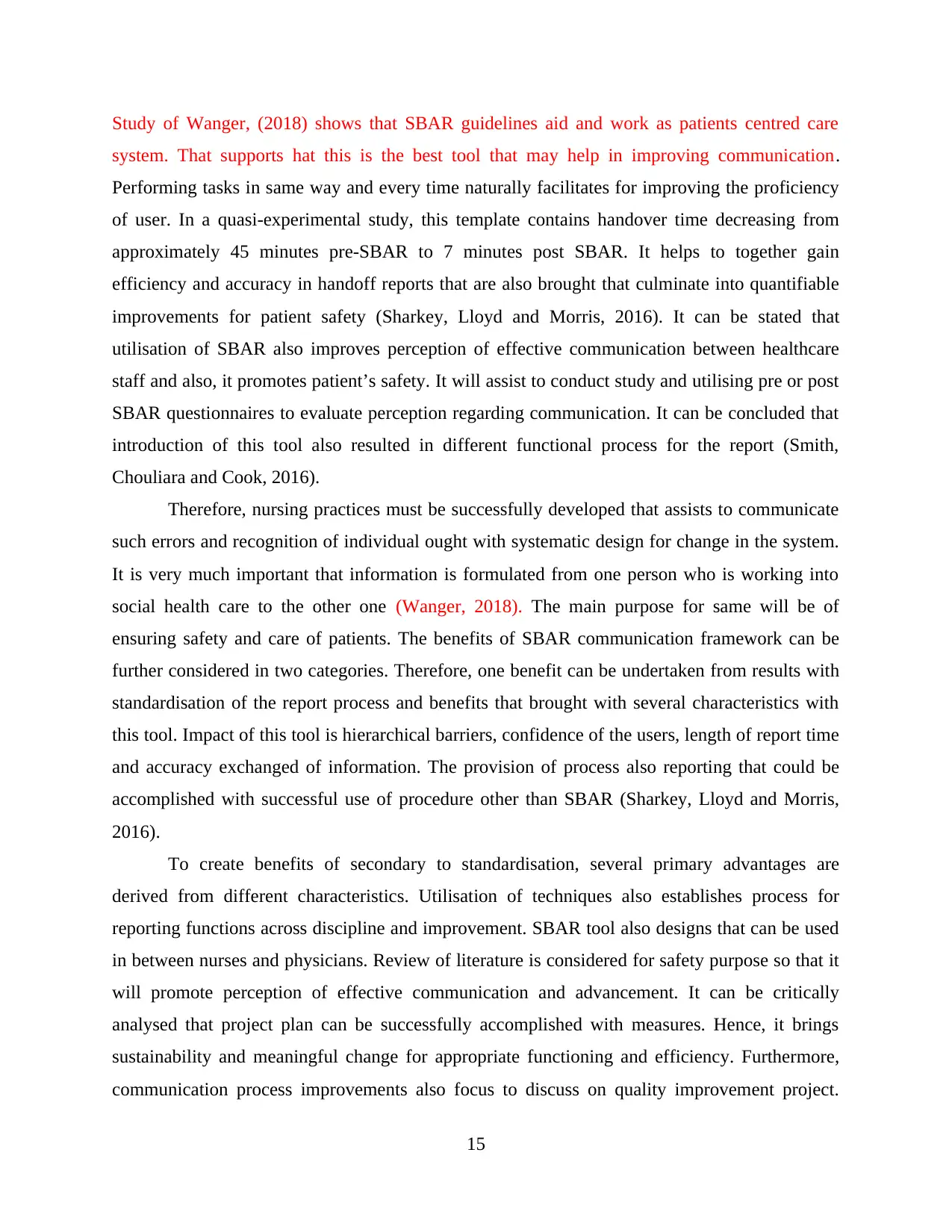
Study of Wanger, (2018) shows that SBAR guidelines aid and work as patients centred care
system. That supports hat this is the best tool that may help in improving communication.
Performing tasks in same way and every time naturally facilitates for improving the proficiency
of user. In a quasi-experimental study, this template contains handover time decreasing from
approximately 45 minutes pre-SBAR to 7 minutes post SBAR. It helps to together gain
efficiency and accuracy in handoff reports that are also brought that culminate into quantifiable
improvements for patient safety (Sharkey, Lloyd and Morris, 2016). It can be stated that
utilisation of SBAR also improves perception of effective communication between healthcare
staff and also, it promotes patient’s safety. It will assist to conduct study and utilising pre or post
SBAR questionnaires to evaluate perception regarding communication. It can be concluded that
introduction of this tool also resulted in different functional process for the report (Smith,
Chouliara and Cook, 2016).
Therefore, nursing practices must be successfully developed that assists to communicate
such errors and recognition of individual ought with systematic design for change in the system.
It is very much important that information is formulated from one person who is working into
social health care to the other one (Wanger, 2018). The main purpose for same will be of
ensuring safety and care of patients. The benefits of SBAR communication framework can be
further considered in two categories. Therefore, one benefit can be undertaken from results with
standardisation of the report process and benefits that brought with several characteristics with
this tool. Impact of this tool is hierarchical barriers, confidence of the users, length of report time
and accuracy exchanged of information. The provision of process also reporting that could be
accomplished with successful use of procedure other than SBAR (Sharkey, Lloyd and Morris,
2016).
To create benefits of secondary to standardisation, several primary advantages are
derived from different characteristics. Utilisation of techniques also establishes process for
reporting functions across discipline and improvement. SBAR tool also designs that can be used
in between nurses and physicians. Review of literature is considered for safety purpose so that it
will promote perception of effective communication and advancement. It can be critically
analysed that project plan can be successfully accomplished with measures. Hence, it brings
sustainability and meaningful change for appropriate functioning and efficiency. Furthermore,
communication process improvements also focus to discuss on quality improvement project.
15
system. That supports hat this is the best tool that may help in improving communication.
Performing tasks in same way and every time naturally facilitates for improving the proficiency
of user. In a quasi-experimental study, this template contains handover time decreasing from
approximately 45 minutes pre-SBAR to 7 minutes post SBAR. It helps to together gain
efficiency and accuracy in handoff reports that are also brought that culminate into quantifiable
improvements for patient safety (Sharkey, Lloyd and Morris, 2016). It can be stated that
utilisation of SBAR also improves perception of effective communication between healthcare
staff and also, it promotes patient’s safety. It will assist to conduct study and utilising pre or post
SBAR questionnaires to evaluate perception regarding communication. It can be concluded that
introduction of this tool also resulted in different functional process for the report (Smith,
Chouliara and Cook, 2016).
Therefore, nursing practices must be successfully developed that assists to communicate
such errors and recognition of individual ought with systematic design for change in the system.
It is very much important that information is formulated from one person who is working into
social health care to the other one (Wanger, 2018). The main purpose for same will be of
ensuring safety and care of patients. The benefits of SBAR communication framework can be
further considered in two categories. Therefore, one benefit can be undertaken from results with
standardisation of the report process and benefits that brought with several characteristics with
this tool. Impact of this tool is hierarchical barriers, confidence of the users, length of report time
and accuracy exchanged of information. The provision of process also reporting that could be
accomplished with successful use of procedure other than SBAR (Sharkey, Lloyd and Morris,
2016).
To create benefits of secondary to standardisation, several primary advantages are
derived from different characteristics. Utilisation of techniques also establishes process for
reporting functions across discipline and improvement. SBAR tool also designs that can be used
in between nurses and physicians. Review of literature is considered for safety purpose so that it
will promote perception of effective communication and advancement. It can be critically
analysed that project plan can be successfully accomplished with measures. Hence, it brings
sustainability and meaningful change for appropriate functioning and efficiency. Furthermore,
communication process improvements also focus to discuss on quality improvement project.
15
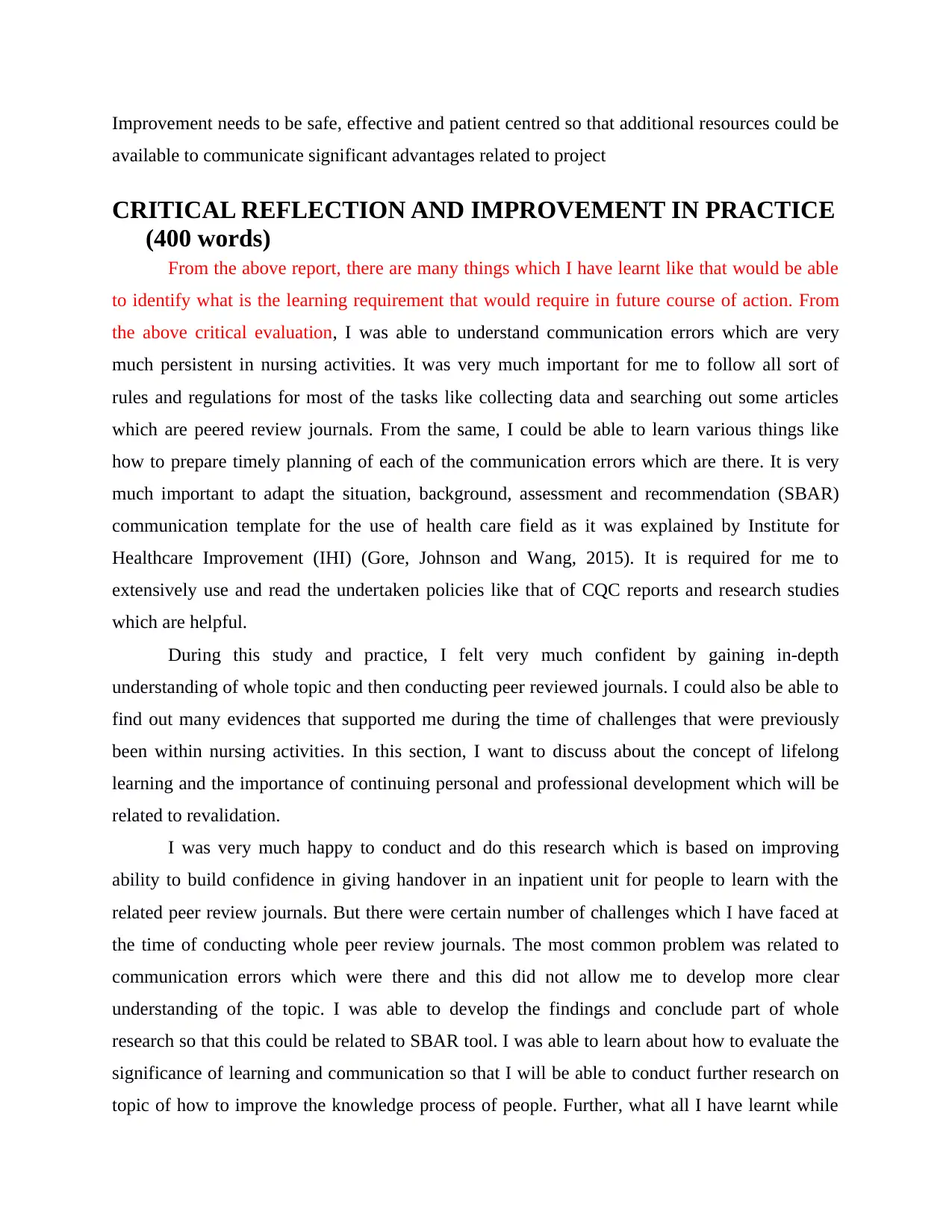
Improvement needs to be safe, effective and patient centred so that additional resources could be
available to communicate significant advantages related to project
CRITICAL REFLECTION AND IMPROVEMENT IN PRACTICE
(400 words)
From the above report, there are many things which I have learnt like that would be able
to identify what is the learning requirement that would require in future course of action. From
the above critical evaluation, I was able to understand communication errors which are very
much persistent in nursing activities. It was very much important for me to follow all sort of
rules and regulations for most of the tasks like collecting data and searching out some articles
which are peered review journals. From the same, I could be able to learn various things like
how to prepare timely planning of each of the communication errors which are there. It is very
much important to adapt the situation, background, assessment and recommendation (SBAR)
communication template for the use of health care field as it was explained by Institute for
Healthcare Improvement (IHI) (Gore, Johnson and Wang, 2015). It is required for me to
extensively use and read the undertaken policies like that of CQC reports and research studies
which are helpful.
During this study and practice, I felt very much confident by gaining in-depth
understanding of whole topic and then conducting peer reviewed journals. I could also be able to
find out many evidences that supported me during the time of challenges that were previously
been within nursing activities. In this section, I want to discuss about the concept of lifelong
learning and the importance of continuing personal and professional development which will be
related to revalidation.
I was very much happy to conduct and do this research which is based on improving
ability to build confidence in giving handover in an inpatient unit for people to learn with the
related peer review journals. But there were certain number of challenges which I have faced at
the time of conducting whole peer review journals. The most common problem was related to
communication errors which were there and this did not allow me to develop more clear
understanding of the topic. I was able to develop the findings and conclude part of whole
research so that this could be related to SBAR tool. I was able to learn about how to evaluate the
significance of learning and communication so that I will be able to conduct further research on
topic of how to improve the knowledge process of people. Further, what all I have learnt while
available to communicate significant advantages related to project
CRITICAL REFLECTION AND IMPROVEMENT IN PRACTICE
(400 words)
From the above report, there are many things which I have learnt like that would be able
to identify what is the learning requirement that would require in future course of action. From
the above critical evaluation, I was able to understand communication errors which are very
much persistent in nursing activities. It was very much important for me to follow all sort of
rules and regulations for most of the tasks like collecting data and searching out some articles
which are peered review journals. From the same, I could be able to learn various things like
how to prepare timely planning of each of the communication errors which are there. It is very
much important to adapt the situation, background, assessment and recommendation (SBAR)
communication template for the use of health care field as it was explained by Institute for
Healthcare Improvement (IHI) (Gore, Johnson and Wang, 2015). It is required for me to
extensively use and read the undertaken policies like that of CQC reports and research studies
which are helpful.
During this study and practice, I felt very much confident by gaining in-depth
understanding of whole topic and then conducting peer reviewed journals. I could also be able to
find out many evidences that supported me during the time of challenges that were previously
been within nursing activities. In this section, I want to discuss about the concept of lifelong
learning and the importance of continuing personal and professional development which will be
related to revalidation.
I was very much happy to conduct and do this research which is based on improving
ability to build confidence in giving handover in an inpatient unit for people to learn with the
related peer review journals. But there were certain number of challenges which I have faced at
the time of conducting whole peer review journals. The most common problem was related to
communication errors which were there and this did not allow me to develop more clear
understanding of the topic. I was able to develop the findings and conclude part of whole
research so that this could be related to SBAR tool. I was able to learn about how to evaluate the
significance of learning and communication so that I will be able to conduct further research on
topic of how to improve the knowledge process of people. Further, what all I have learnt while
Secure Best Marks with AI Grader
Need help grading? Try our AI Grader for instant feedback on your assignments.
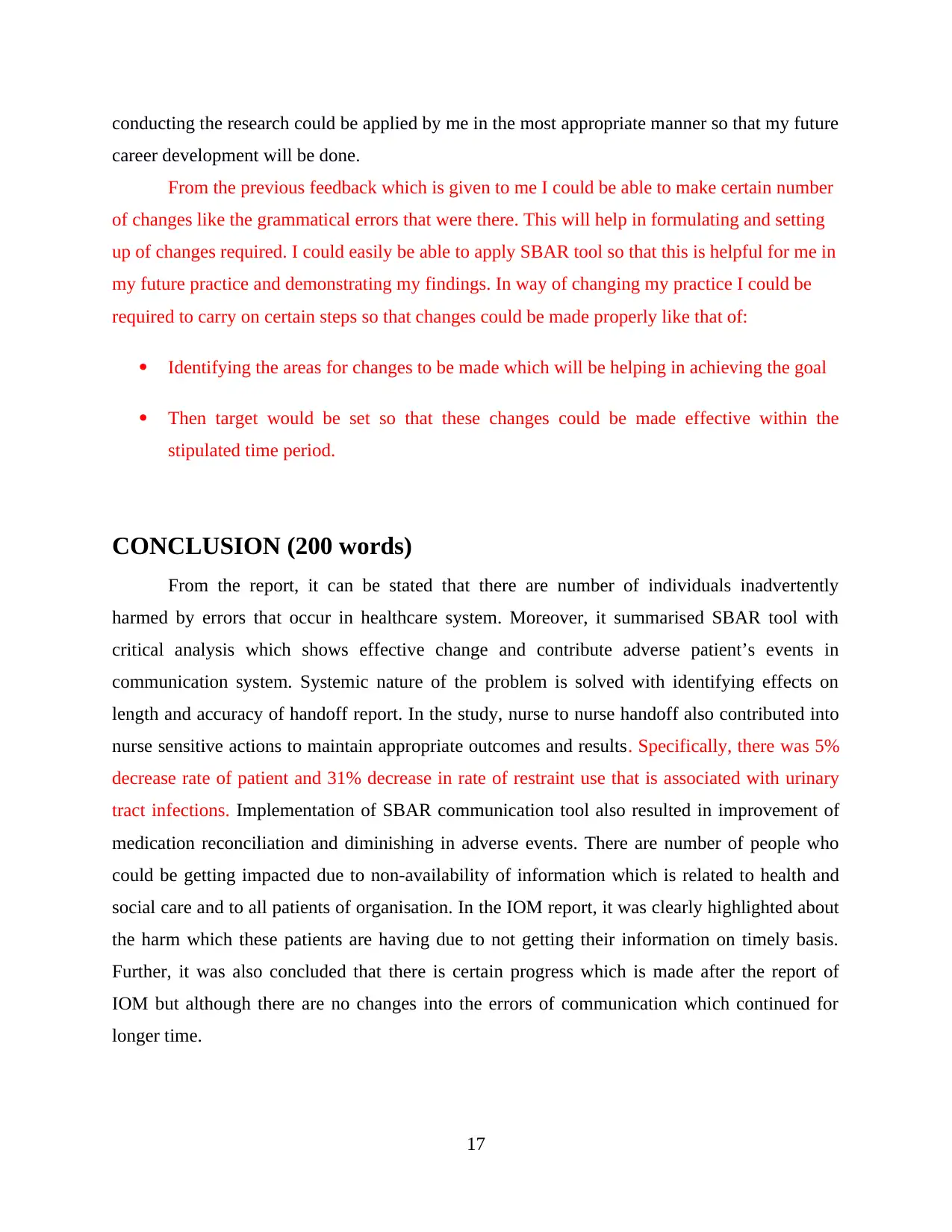
conducting the research could be applied by me in the most appropriate manner so that my future
career development will be done.
From the previous feedback which is given to me I could be able to make certain number
of changes like the grammatical errors that were there. This will help in formulating and setting
up of changes required. I could easily be able to apply SBAR tool so that this is helpful for me in
my future practice and demonstrating my findings. In way of changing my practice I could be
required to carry on certain steps so that changes could be made properly like that of:
Identifying the areas for changes to be made which will be helping in achieving the goal
Then target would be set so that these changes could be made effective within the
stipulated time period.
CONCLUSION (200 words)
From the report, it can be stated that there are number of individuals inadvertently
harmed by errors that occur in healthcare system. Moreover, it summarised SBAR tool with
critical analysis which shows effective change and contribute adverse patient’s events in
communication system. Systemic nature of the problem is solved with identifying effects on
length and accuracy of handoff report. In the study, nurse to nurse handoff also contributed into
nurse sensitive actions to maintain appropriate outcomes and results. Specifically, there was 5%
decrease rate of patient and 31% decrease in rate of restraint use that is associated with urinary
tract infections. Implementation of SBAR communication tool also resulted in improvement of
medication reconciliation and diminishing in adverse events. There are number of people who
could be getting impacted due to non-availability of information which is related to health and
social care and to all patients of organisation. In the IOM report, it was clearly highlighted about
the harm which these patients are having due to not getting their information on timely basis.
Further, it was also concluded that there is certain progress which is made after the report of
IOM but although there are no changes into the errors of communication which continued for
longer time.
17
career development will be done.
From the previous feedback which is given to me I could be able to make certain number
of changes like the grammatical errors that were there. This will help in formulating and setting
up of changes required. I could easily be able to apply SBAR tool so that this is helpful for me in
my future practice and demonstrating my findings. In way of changing my practice I could be
required to carry on certain steps so that changes could be made properly like that of:
Identifying the areas for changes to be made which will be helping in achieving the goal
Then target would be set so that these changes could be made effective within the
stipulated time period.
CONCLUSION (200 words)
From the report, it can be stated that there are number of individuals inadvertently
harmed by errors that occur in healthcare system. Moreover, it summarised SBAR tool with
critical analysis which shows effective change and contribute adverse patient’s events in
communication system. Systemic nature of the problem is solved with identifying effects on
length and accuracy of handoff report. In the study, nurse to nurse handoff also contributed into
nurse sensitive actions to maintain appropriate outcomes and results. Specifically, there was 5%
decrease rate of patient and 31% decrease in rate of restraint use that is associated with urinary
tract infections. Implementation of SBAR communication tool also resulted in improvement of
medication reconciliation and diminishing in adverse events. There are number of people who
could be getting impacted due to non-availability of information which is related to health and
social care and to all patients of organisation. In the IOM report, it was clearly highlighted about
the harm which these patients are having due to not getting their information on timely basis.
Further, it was also concluded that there is certain progress which is made after the report of
IOM but although there are no changes into the errors of communication which continued for
longer time.
17
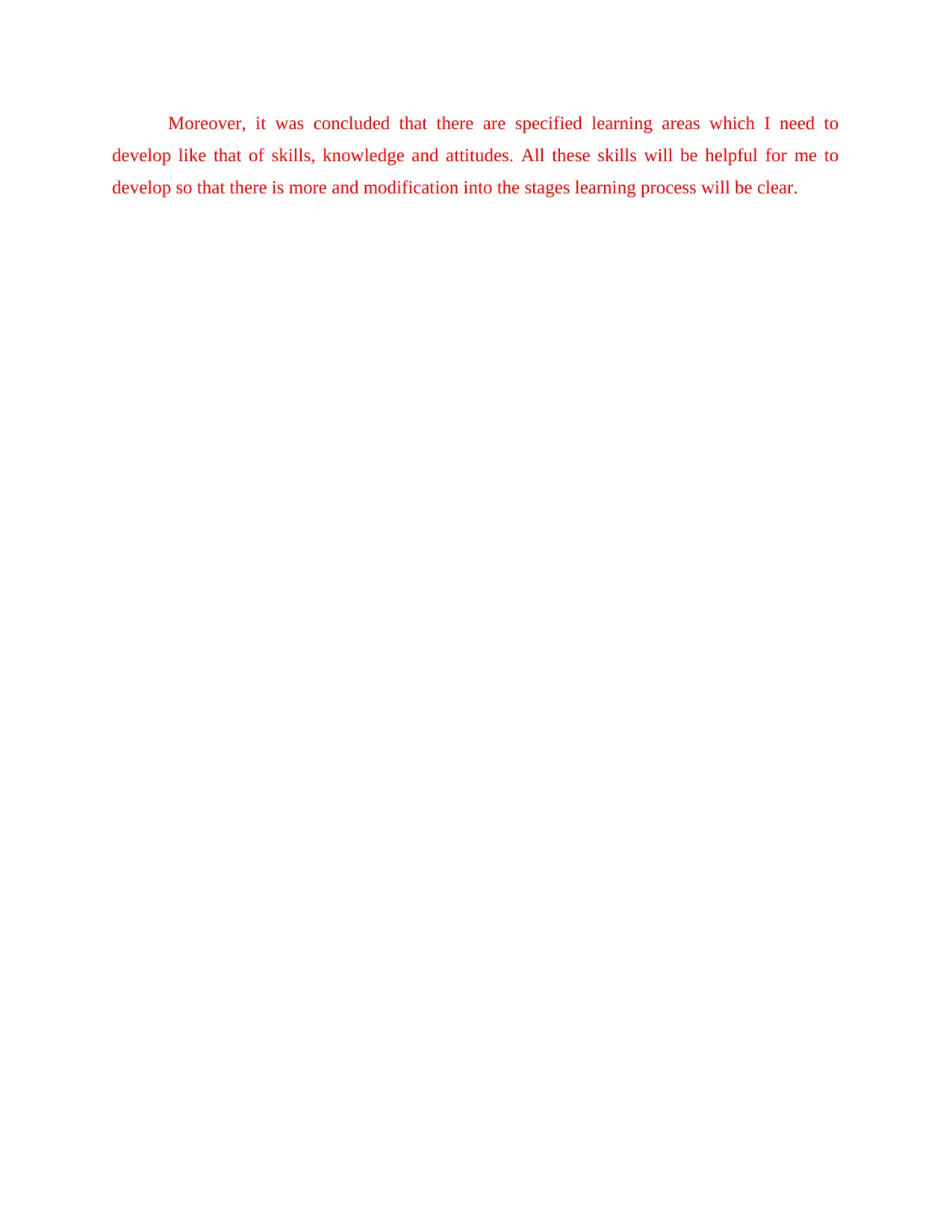
Moreover, it was concluded that there are specified learning areas which I need to
develop like that of skills, knowledge and attitudes. All these skills will be helpful for me to
develop so that there is more and modification into the stages learning process will be clear.
develop like that of skills, knowledge and attitudes. All these skills will be helpful for me to
develop so that there is more and modification into the stages learning process will be clear.
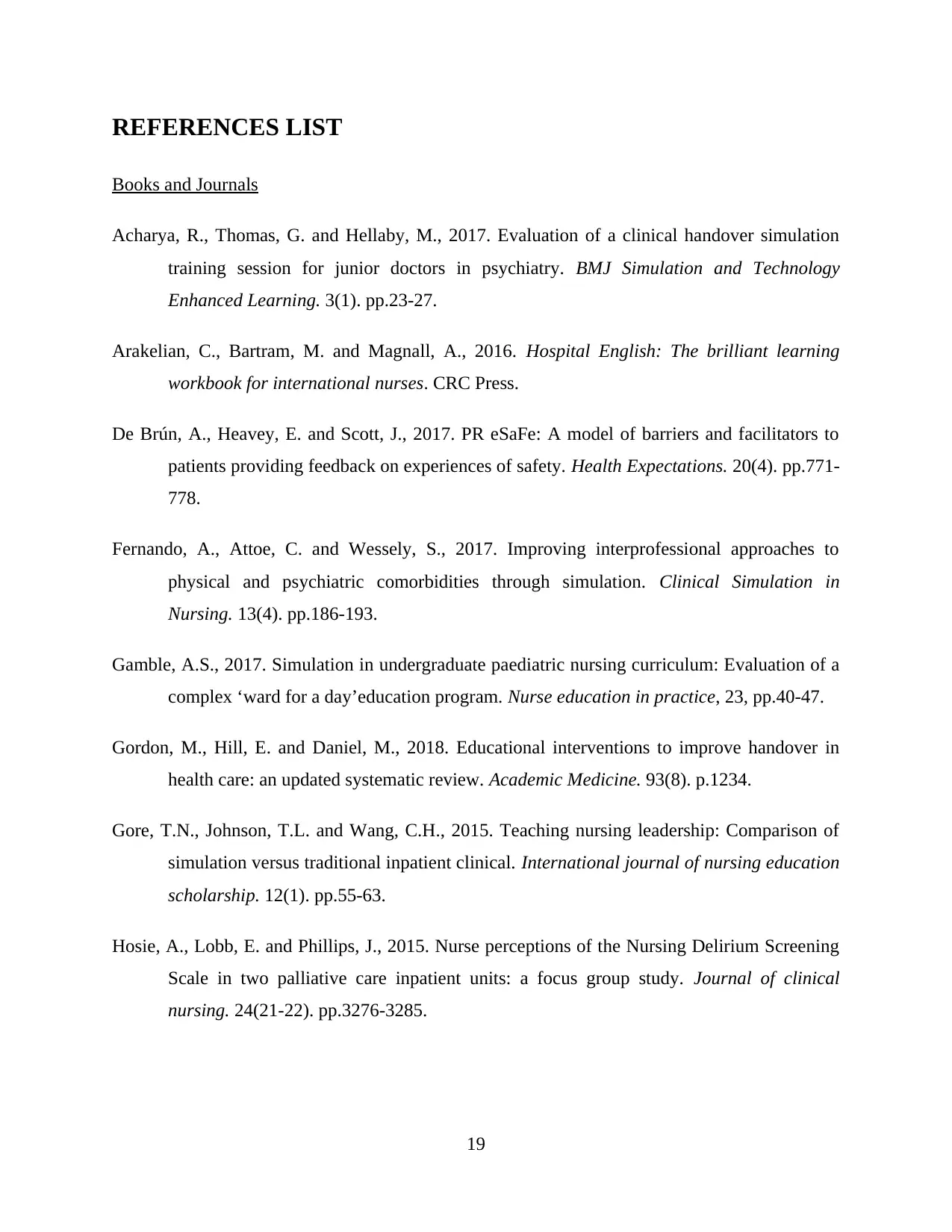
REFERENCES LIST
Books and Journals
Acharya, R., Thomas, G. and Hellaby, M., 2017. Evaluation of a clinical handover simulation
training session for junior doctors in psychiatry. BMJ Simulation and Technology
Enhanced Learning. 3(1). pp.23-27.
Arakelian, C., Bartram, M. and Magnall, A., 2016. Hospital English: The brilliant learning
workbook for international nurses. CRC Press.
De Brún, A., Heavey, E. and Scott, J., 2017. PR eSaFe: A model of barriers and facilitators to
patients providing feedback on experiences of safety. Health Expectations. 20(4). pp.771-
778.
Fernando, A., Attoe, C. and Wessely, S., 2017. Improving interprofessional approaches to
physical and psychiatric comorbidities through simulation. Clinical Simulation in
Nursing. 13(4). pp.186-193.
Gamble, A.S., 2017. Simulation in undergraduate paediatric nursing curriculum: Evaluation of a
complex ‘ward for a day’education program. Nurse education in practice, 23, pp.40-47.
Gordon, M., Hill, E. and Daniel, M., 2018. Educational interventions to improve handover in
health care: an updated systematic review. Academic Medicine. 93(8). p.1234.
Gore, T.N., Johnson, T.L. and Wang, C.H., 2015. Teaching nursing leadership: Comparison of
simulation versus traditional inpatient clinical. International journal of nursing education
scholarship. 12(1). pp.55-63.
Hosie, A., Lobb, E. and Phillips, J., 2015. Nurse perceptions of the Nursing Delirium Screening
Scale in two palliative care inpatient units: a focus group study. Journal of clinical
nursing. 24(21-22). pp.3276-3285.
19
Books and Journals
Acharya, R., Thomas, G. and Hellaby, M., 2017. Evaluation of a clinical handover simulation
training session for junior doctors in psychiatry. BMJ Simulation and Technology
Enhanced Learning. 3(1). pp.23-27.
Arakelian, C., Bartram, M. and Magnall, A., 2016. Hospital English: The brilliant learning
workbook for international nurses. CRC Press.
De Brún, A., Heavey, E. and Scott, J., 2017. PR eSaFe: A model of barriers and facilitators to
patients providing feedback on experiences of safety. Health Expectations. 20(4). pp.771-
778.
Fernando, A., Attoe, C. and Wessely, S., 2017. Improving interprofessional approaches to
physical and psychiatric comorbidities through simulation. Clinical Simulation in
Nursing. 13(4). pp.186-193.
Gamble, A.S., 2017. Simulation in undergraduate paediatric nursing curriculum: Evaluation of a
complex ‘ward for a day’education program. Nurse education in practice, 23, pp.40-47.
Gordon, M., Hill, E. and Daniel, M., 2018. Educational interventions to improve handover in
health care: an updated systematic review. Academic Medicine. 93(8). p.1234.
Gore, T.N., Johnson, T.L. and Wang, C.H., 2015. Teaching nursing leadership: Comparison of
simulation versus traditional inpatient clinical. International journal of nursing education
scholarship. 12(1). pp.55-63.
Hosie, A., Lobb, E. and Phillips, J., 2015. Nurse perceptions of the Nursing Delirium Screening
Scale in two palliative care inpatient units: a focus group study. Journal of clinical
nursing. 24(21-22). pp.3276-3285.
19
Paraphrase This Document
Need a fresh take? Get an instant paraphrase of this document with our AI Paraphraser

Mikkonen, K., Pitkäjärvi, M. and Kääriäinen, M., 2017. International Healthcare Students in
Clinical Learning Environments. In Professional Learning in the Work Place for
International Students (pp. 147-163). Springer, Cham.
Penney, W., Poulter, N. and Wellard, S., 2016. Nursing assessment of older people who are in
hospital: exploring registered nurses’ understanding of their assessment skills.
Contemporary nurse. 52(2-3), pp.313-325.
Sharkey, S., Lloyd, C. and Morris, C., 2016. Communicating with disabled children when
inpatients: barriers and facilitators identified by parents and professionals in a qualitative
study. Health expectations. 19(3). pp.738-750.
Smith, V., Chouliara, Z. and Cook, M., 2016. The experience of specialist inpatient treatment for
anorexia nervosa: A qualitative study from adult patients’ perspectives. Journal of Health
Psychology. 21(1). pp.16-27.
Sonntag, O., Plebani, M. and Lee, M., 2016. Effective communication in clinical handover: from
research to practice (Vol. 15). Walter de Gruyter GmbH & Co KG.
Tully, V., Al-Salti, S. and Davey, P., 2018. Interprofessional, student-led intervention to improve
insulin prescribing to patients in an Acute Surgical Receiving Unit. BMJ Open Qual.
7(2). p.e000305.
Van Sluisveld, N., Hesselink, G. and Zegers, M., 2015. Improving clinical handover between
intensive care unit and general ward professionals at intensive care unit discharge.
Intensive care medicine. 41(4). pp.589-604.
Wagner, E.A., 2018. Improving Patient Care Outcomes through Better Delegation-
Communication between Nurses and Assistive Personnel. Journal of nursing care
quality. 33(2). pp.187-193.
Watson, P. and O'Brien, J., 2017. The Junior Doctor Survival Guide-EPub3. Elsevier Health
Sciences.
Clinical Learning Environments. In Professional Learning in the Work Place for
International Students (pp. 147-163). Springer, Cham.
Penney, W., Poulter, N. and Wellard, S., 2016. Nursing assessment of older people who are in
hospital: exploring registered nurses’ understanding of their assessment skills.
Contemporary nurse. 52(2-3), pp.313-325.
Sharkey, S., Lloyd, C. and Morris, C., 2016. Communicating with disabled children when
inpatients: barriers and facilitators identified by parents and professionals in a qualitative
study. Health expectations. 19(3). pp.738-750.
Smith, V., Chouliara, Z. and Cook, M., 2016. The experience of specialist inpatient treatment for
anorexia nervosa: A qualitative study from adult patients’ perspectives. Journal of Health
Psychology. 21(1). pp.16-27.
Sonntag, O., Plebani, M. and Lee, M., 2016. Effective communication in clinical handover: from
research to practice (Vol. 15). Walter de Gruyter GmbH & Co KG.
Tully, V., Al-Salti, S. and Davey, P., 2018. Interprofessional, student-led intervention to improve
insulin prescribing to patients in an Acute Surgical Receiving Unit. BMJ Open Qual.
7(2). p.e000305.
Van Sluisveld, N., Hesselink, G. and Zegers, M., 2015. Improving clinical handover between
intensive care unit and general ward professionals at intensive care unit discharge.
Intensive care medicine. 41(4). pp.589-604.
Wagner, E.A., 2018. Improving Patient Care Outcomes through Better Delegation-
Communication between Nurses and Assistive Personnel. Journal of nursing care
quality. 33(2). pp.187-193.
Watson, P. and O'Brien, J., 2017. The Junior Doctor Survival Guide-EPub3. Elsevier Health
Sciences.

Wellman, J., Jeffries, H. and Hagan, P., 2016. Leading the lean healthcare journey: driving
culture change to increase value. CRC Press.
Online
Entwistle, F., 2018. How can you help build students’ confidence in giving handovers?. [Online]
Available through: <https://www.nursingtimes.net/how-can-you-help-build-students-
confidence-in-giving-handovers/5072677.blog>.
What makes a good handover? 2018. [Online] Available through:
<https://www.nursingtimes.net/students/what-makes-a-goodhandover/5038664.article>.
21
culture change to increase value. CRC Press.
Online
Entwistle, F., 2018. How can you help build students’ confidence in giving handovers?. [Online]
Available through: <https://www.nursingtimes.net/how-can-you-help-build-students-
confidence-in-giving-handovers/5072677.blog>.
What makes a good handover? 2018. [Online] Available through:
<https://www.nursingtimes.net/students/what-makes-a-goodhandover/5038664.article>.
21

22
Secure Best Marks with AI Grader
Need help grading? Try our AI Grader for instant feedback on your assignments.

LPD3 Summative Template 2018
1 out of 23
Related Documents
Your All-in-One AI-Powered Toolkit for Academic Success.
+13062052269
info@desklib.com
Available 24*7 on WhatsApp / Email
![[object Object]](/_next/static/media/star-bottom.7253800d.svg)
Unlock your academic potential
© 2024 | Zucol Services PVT LTD | All rights reserved.





